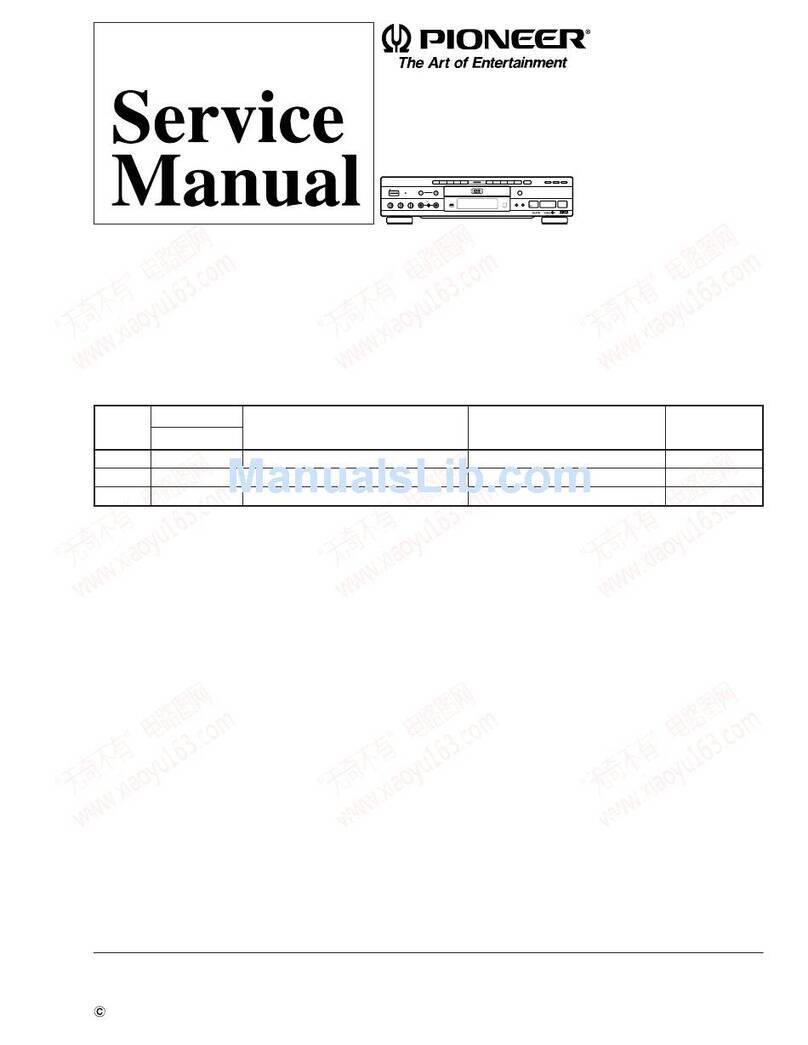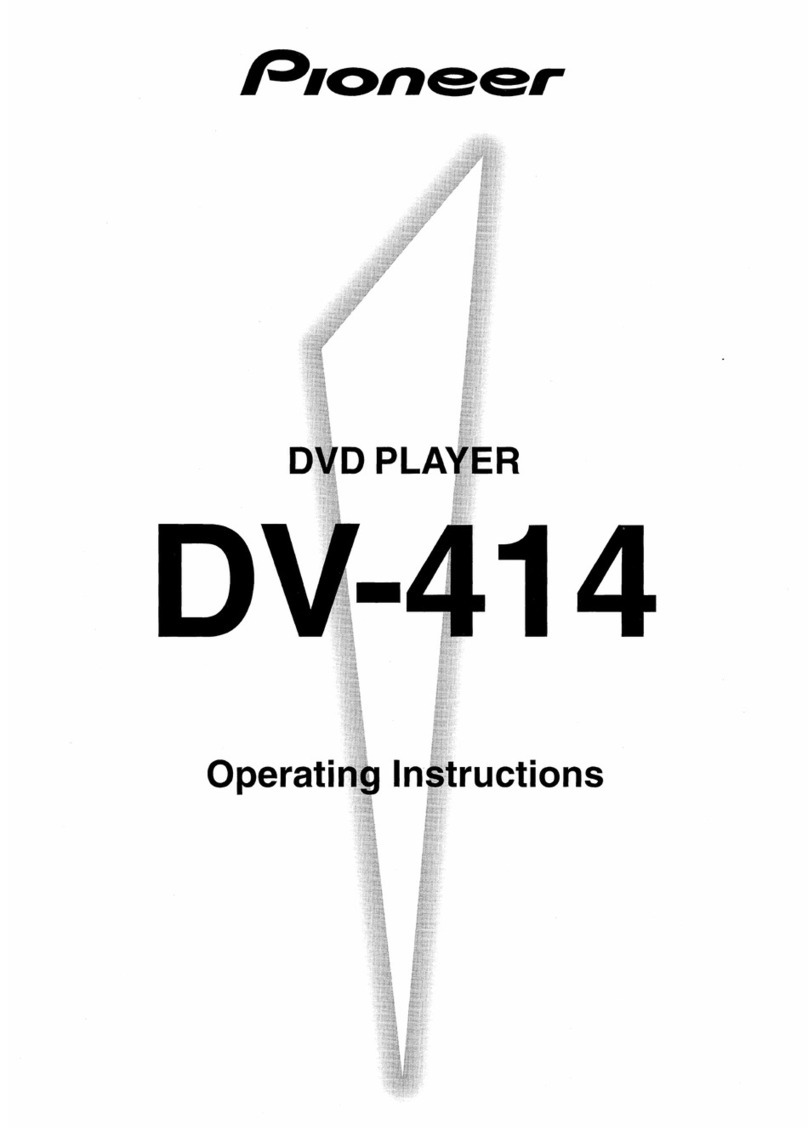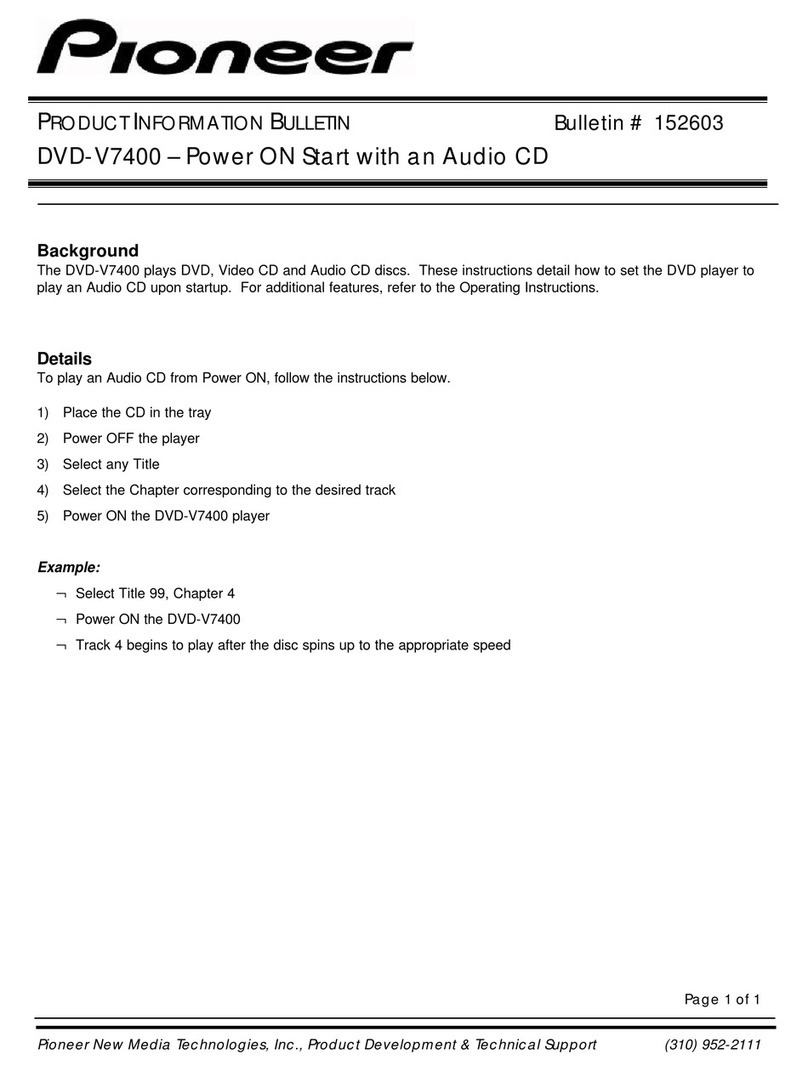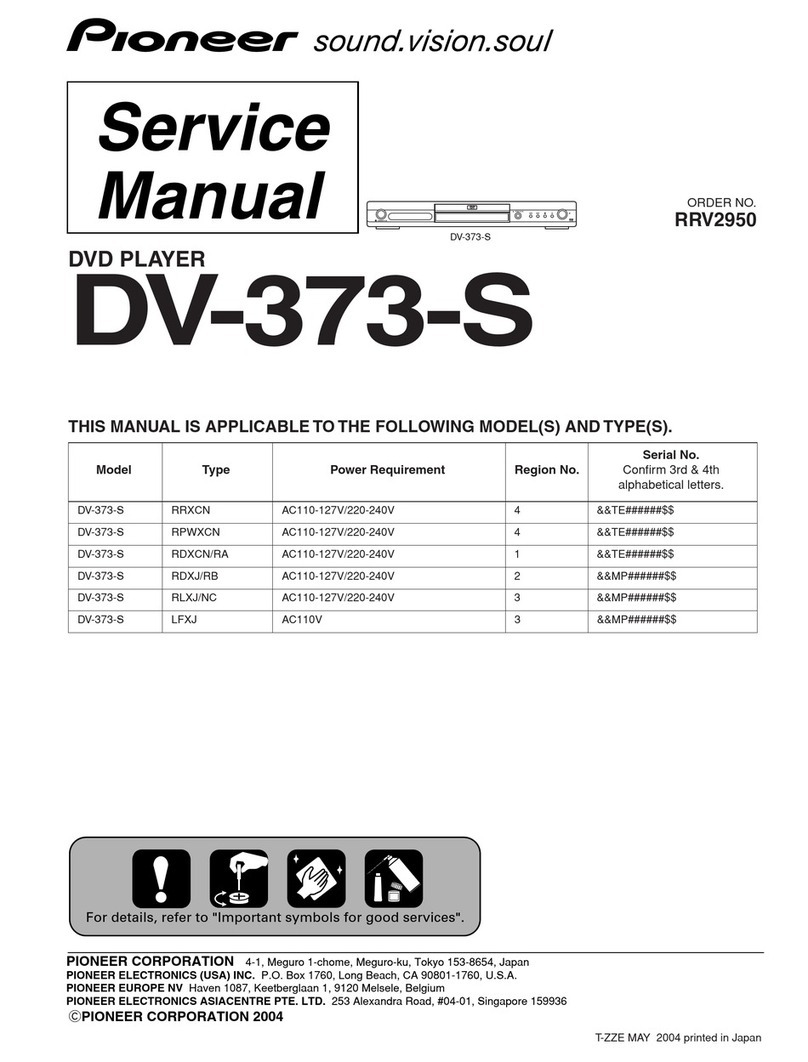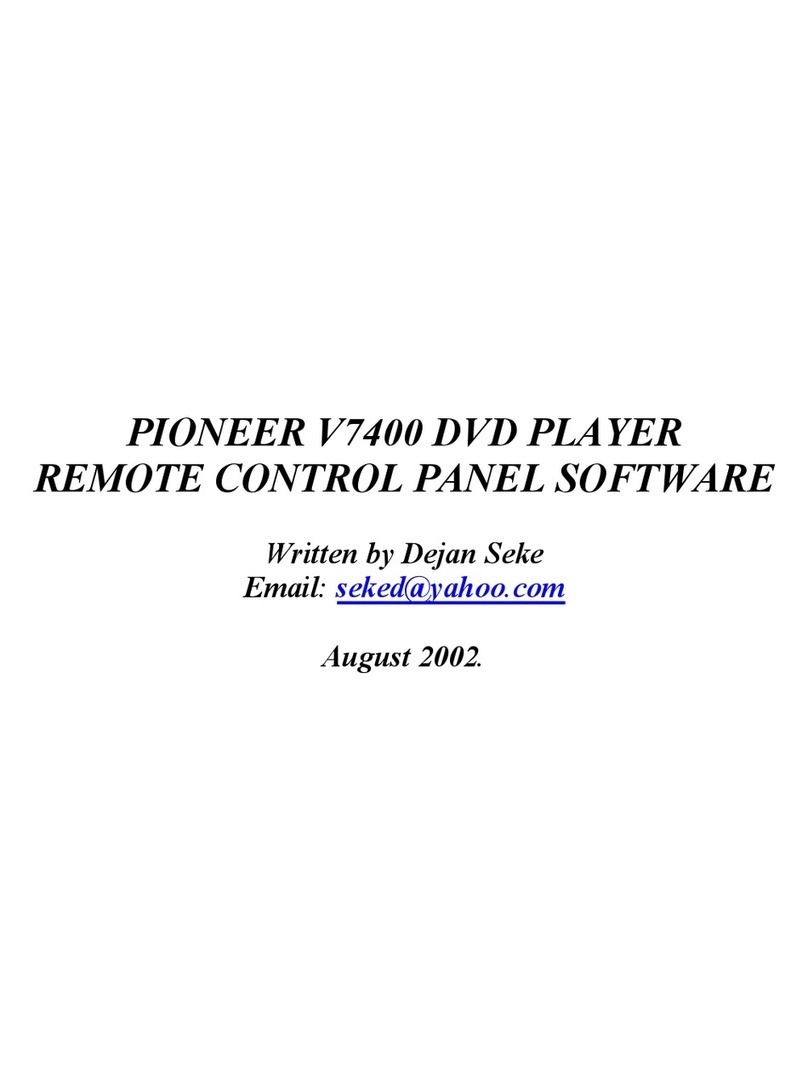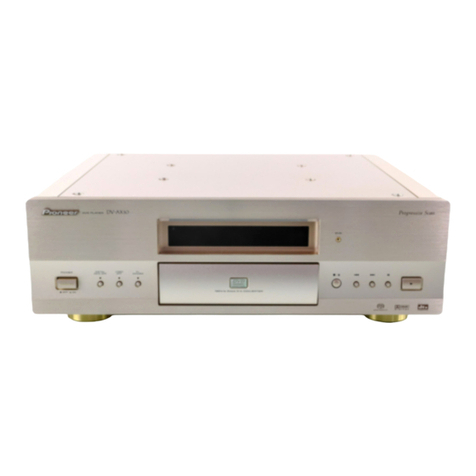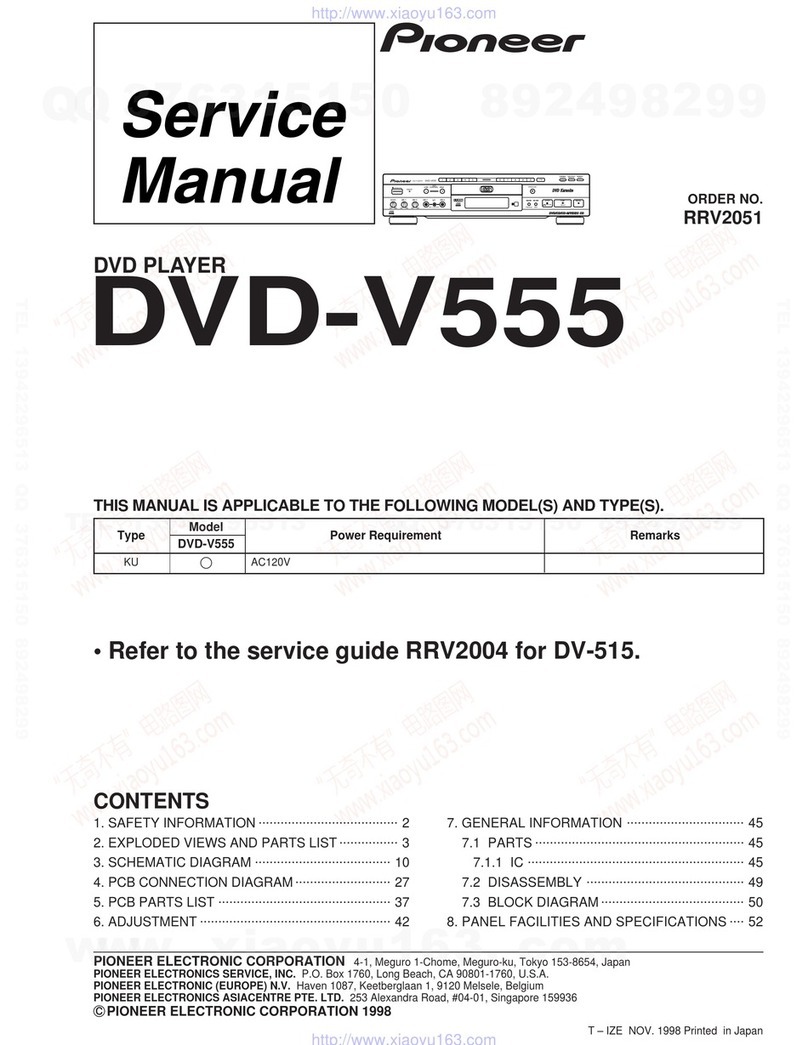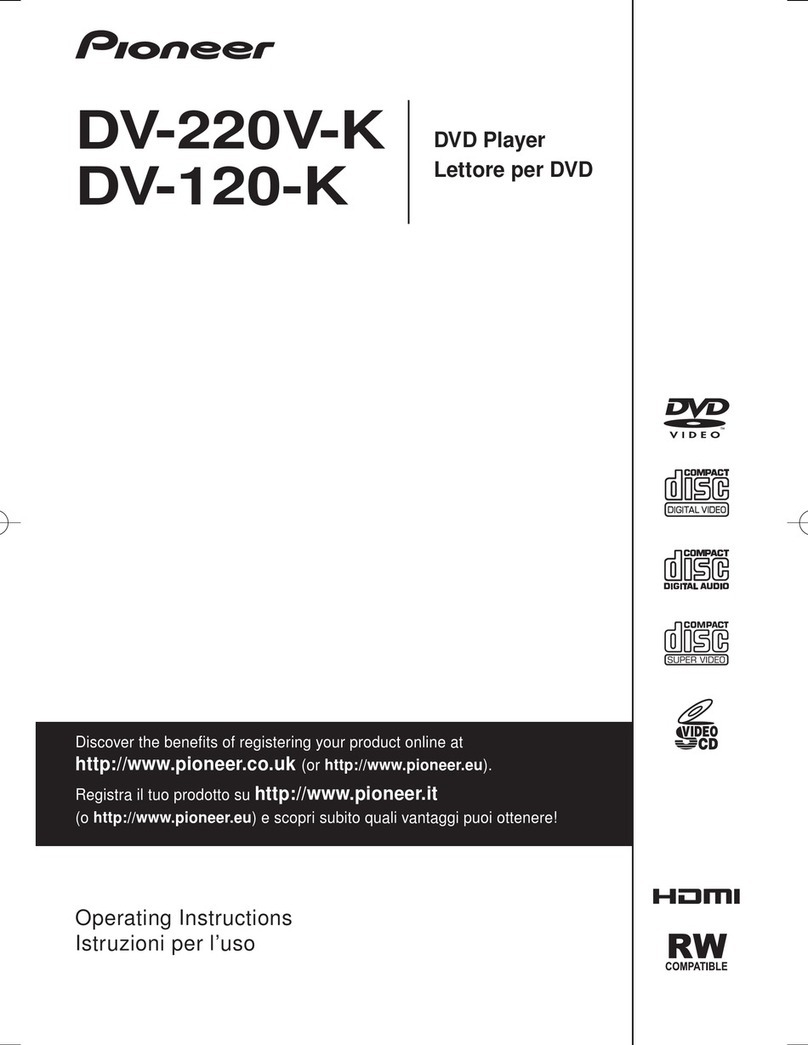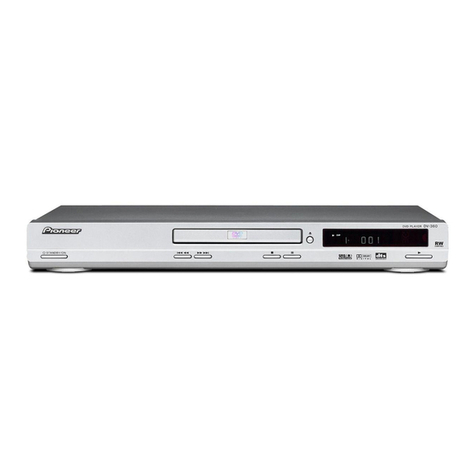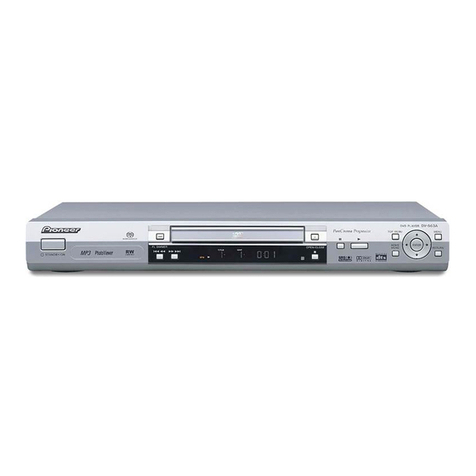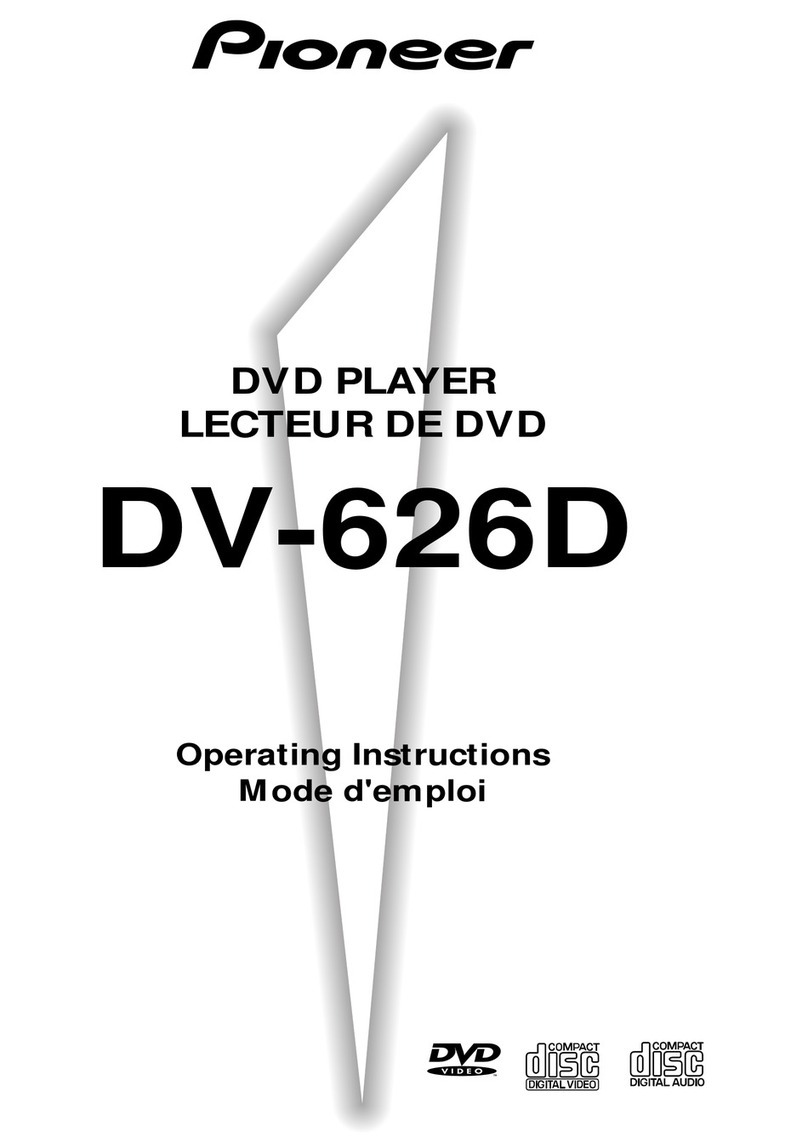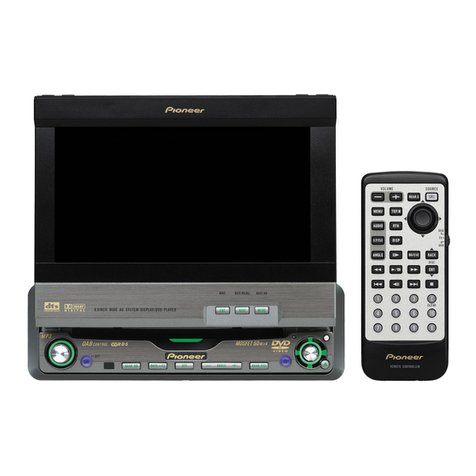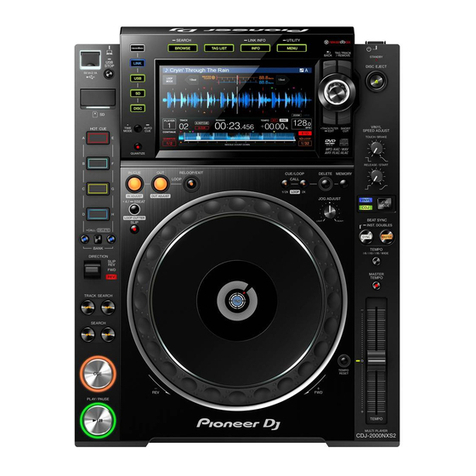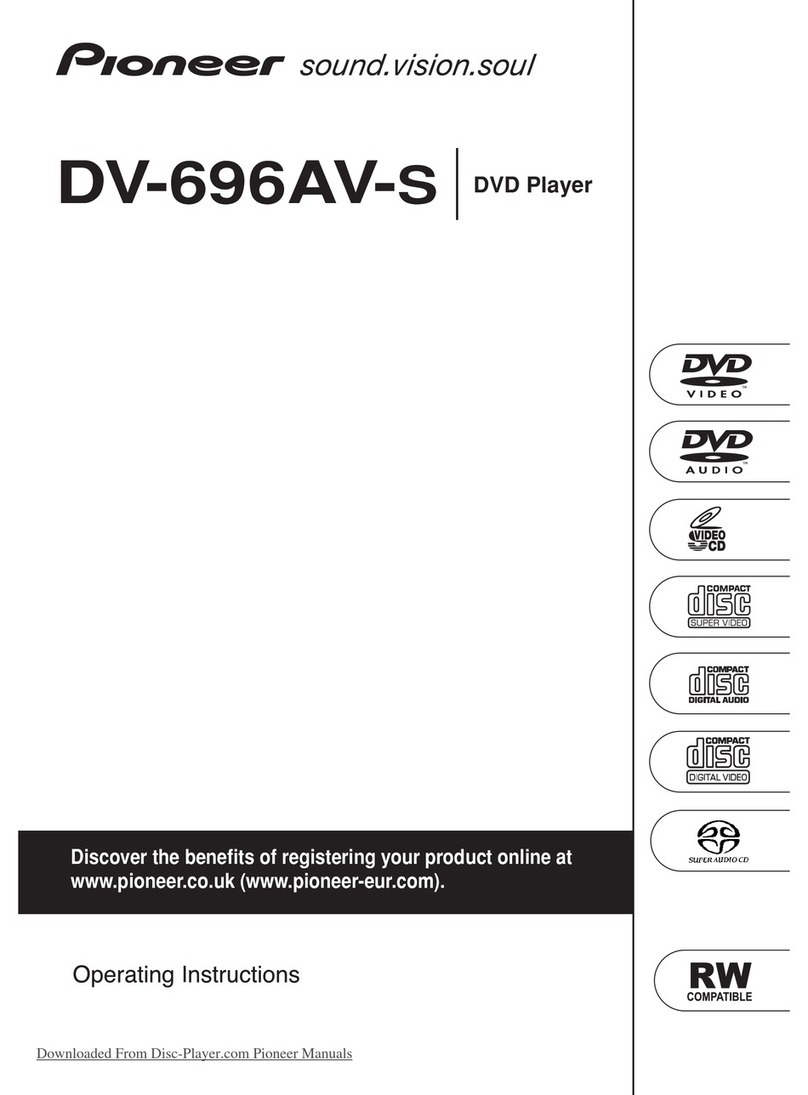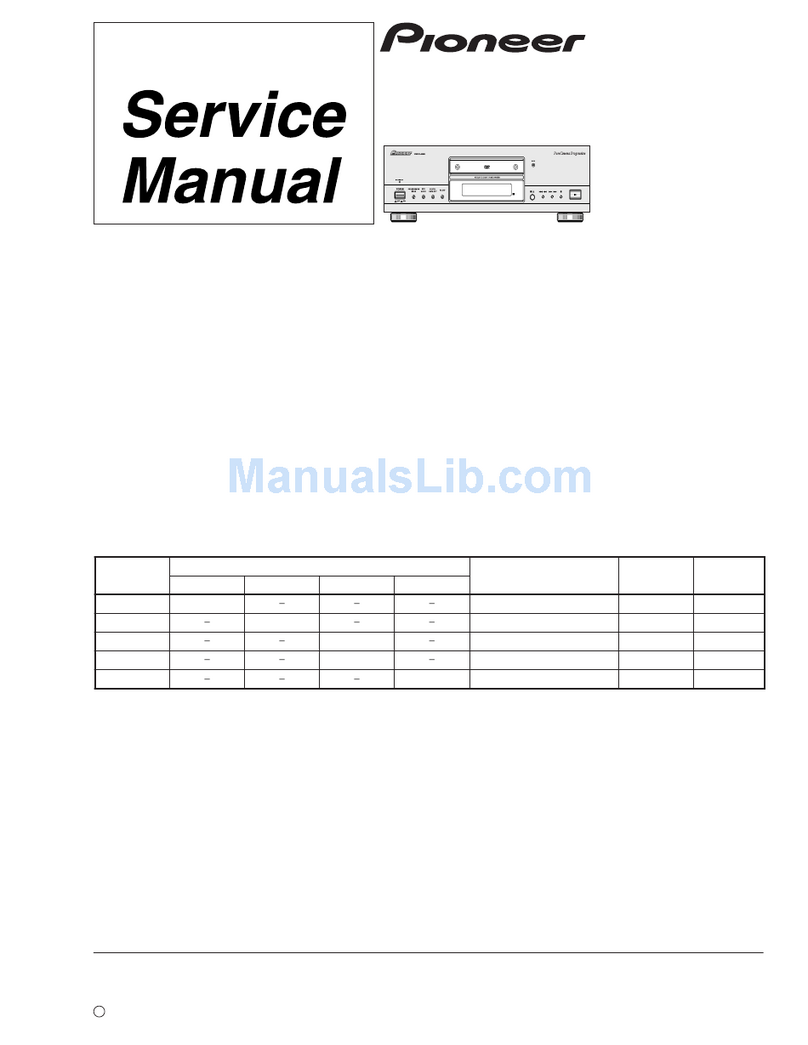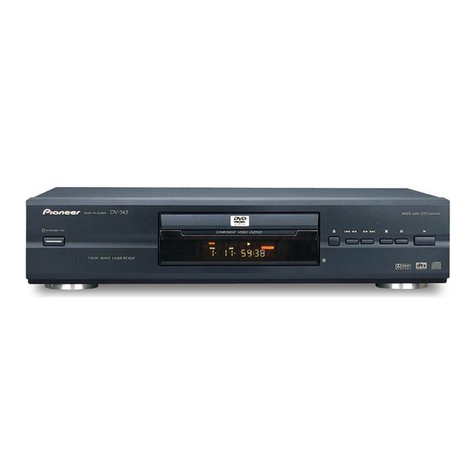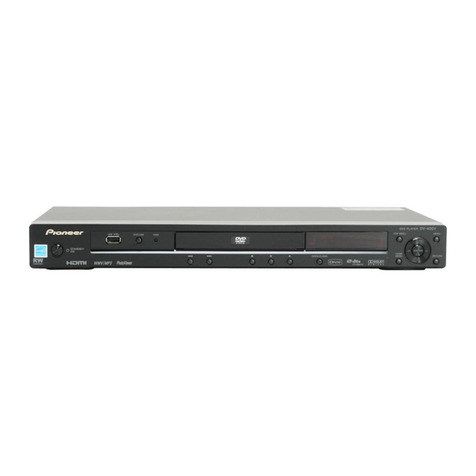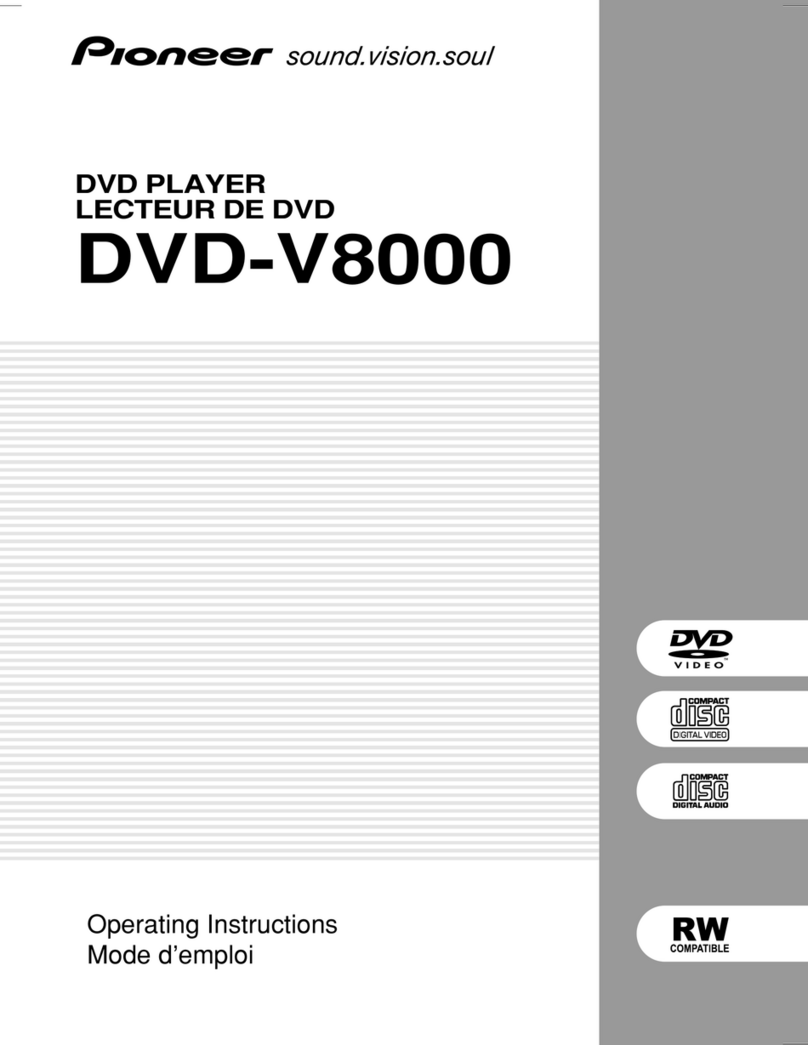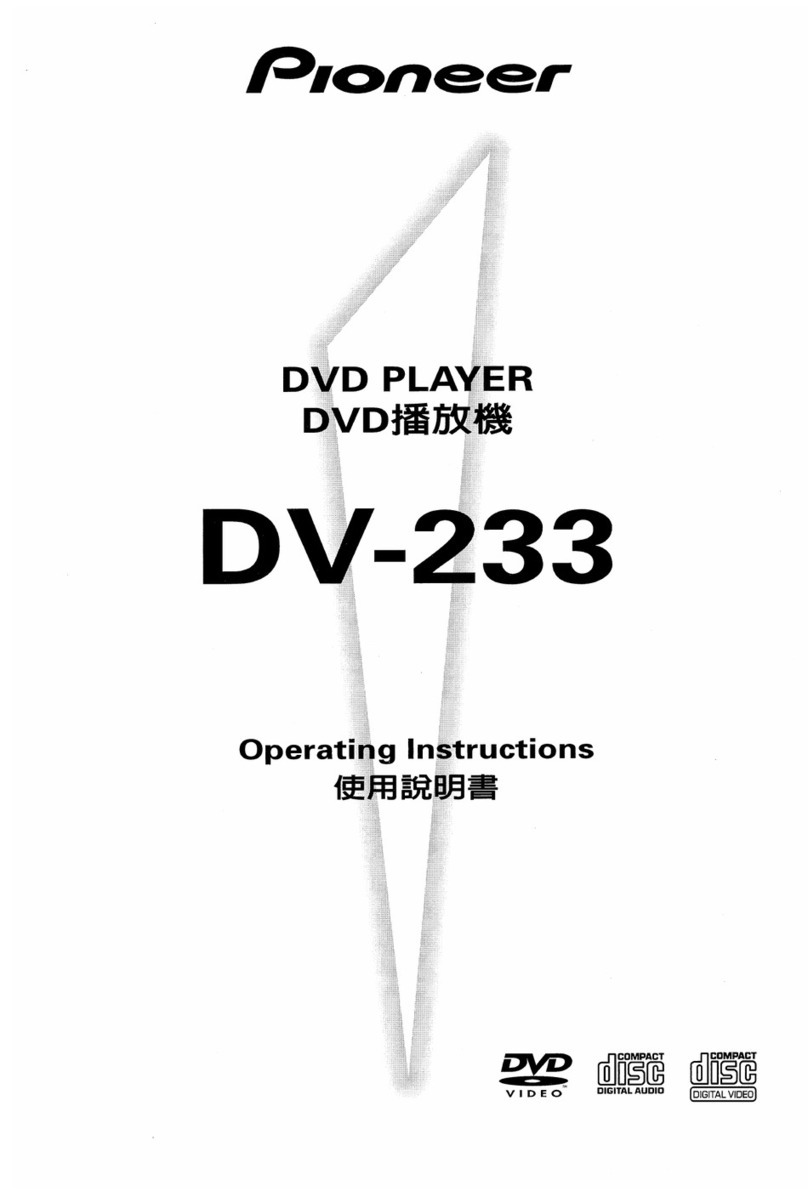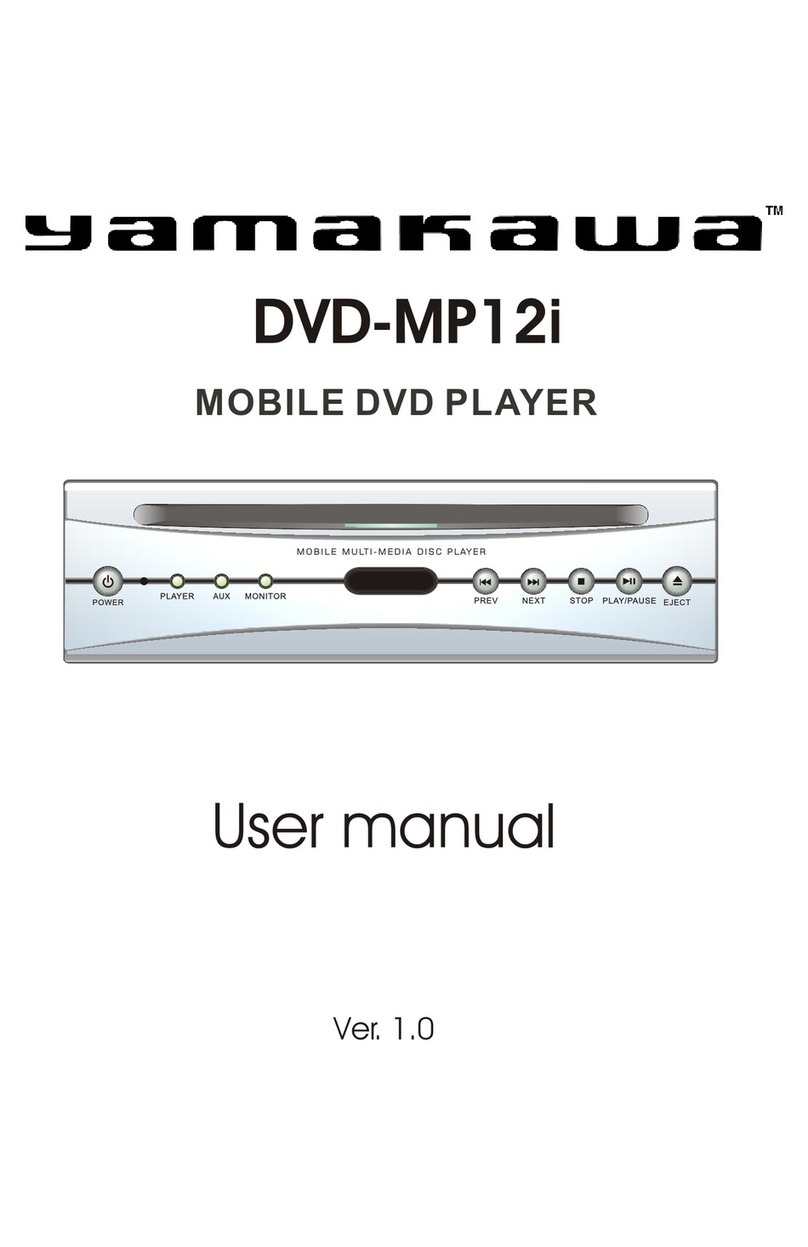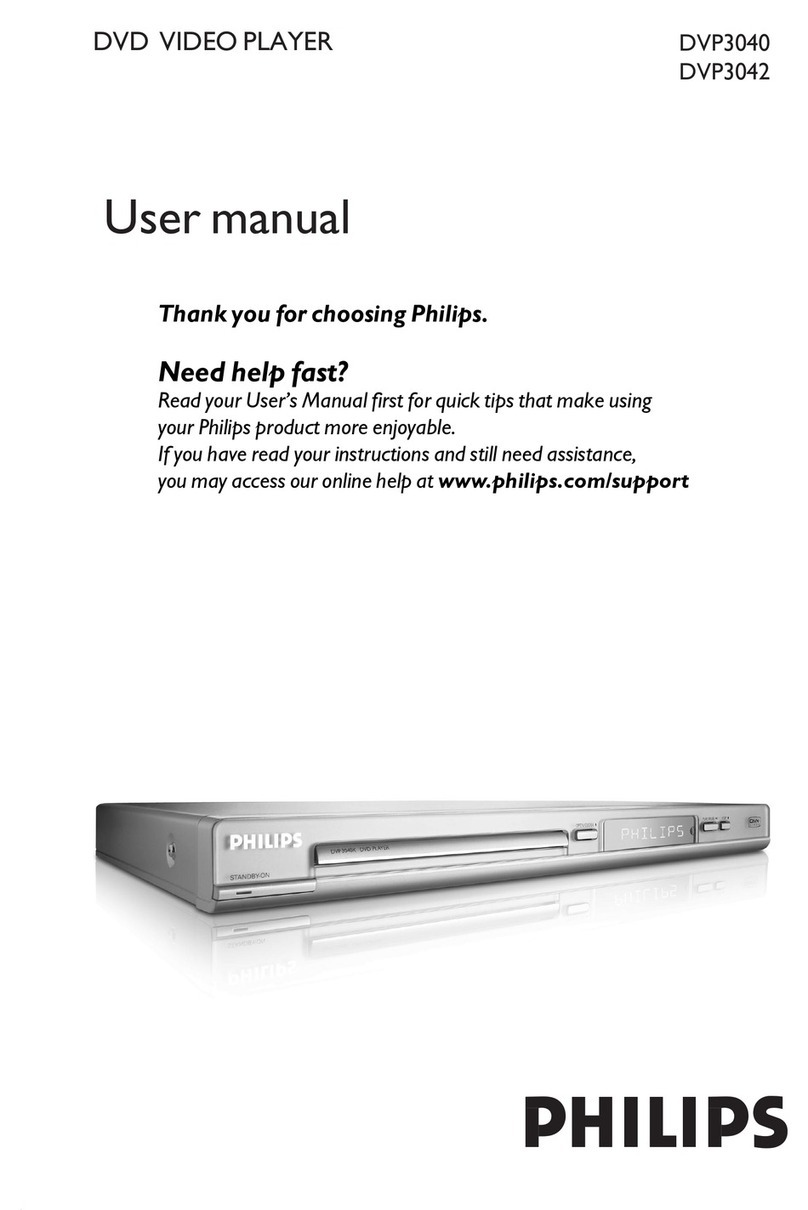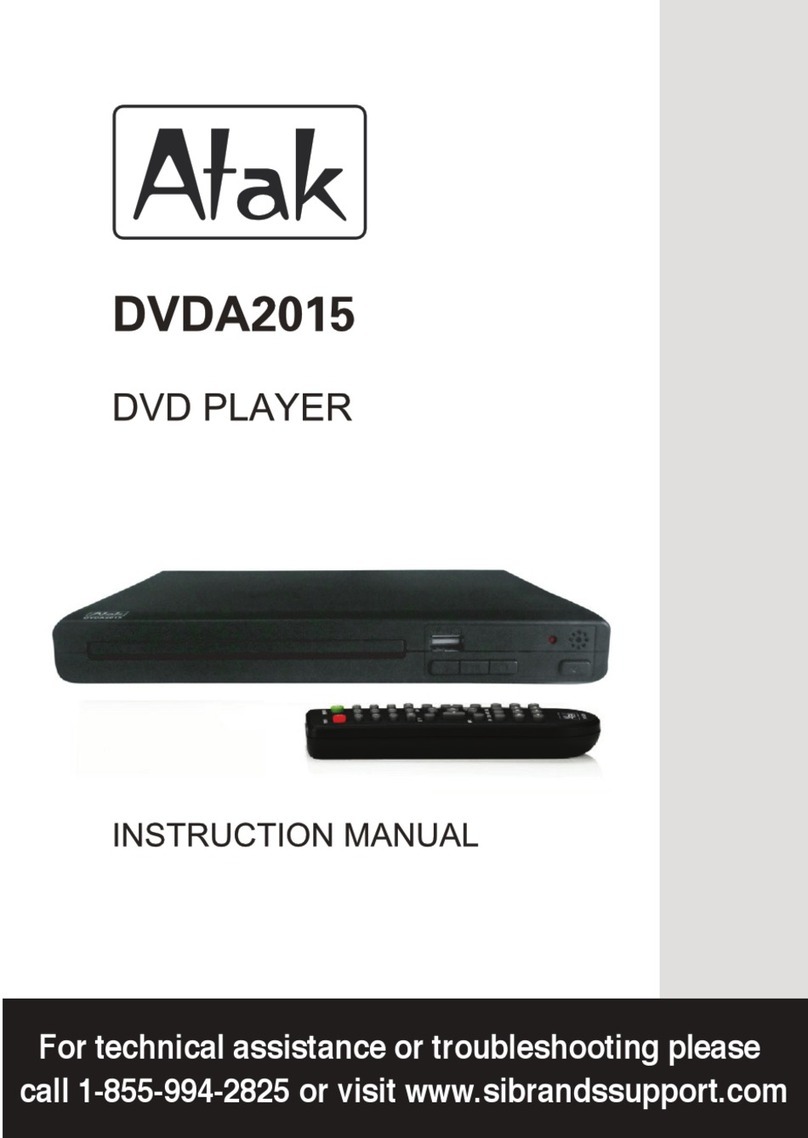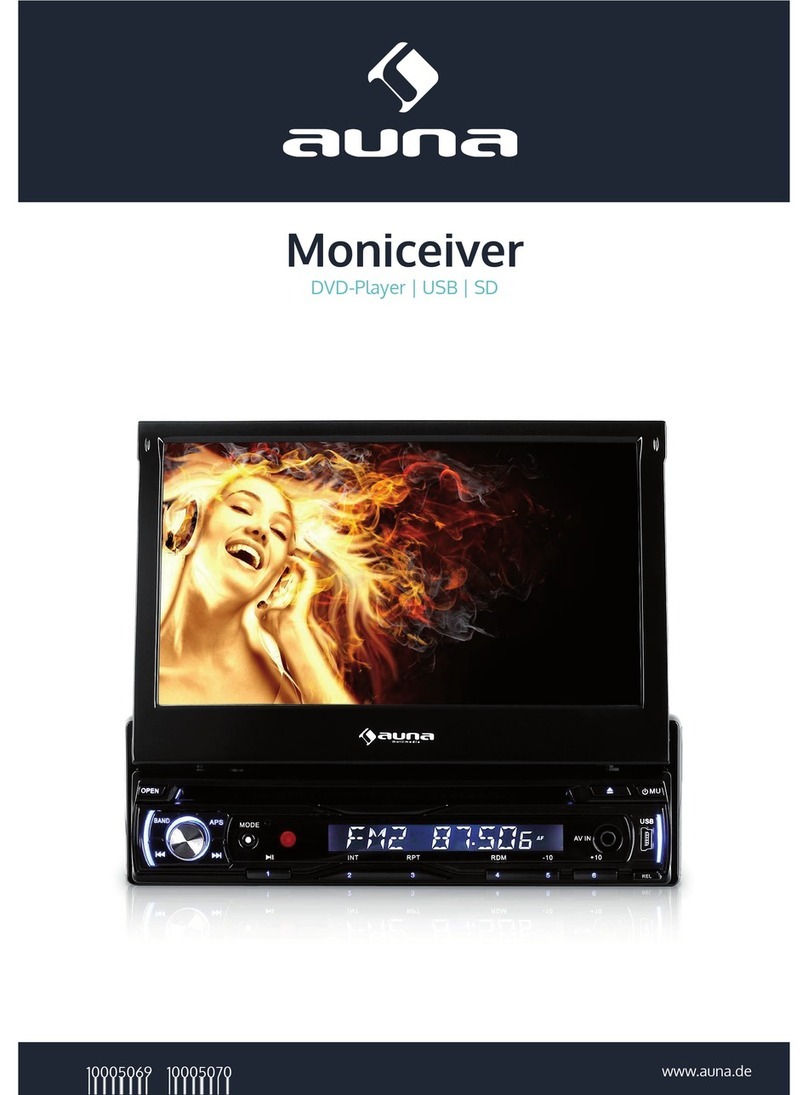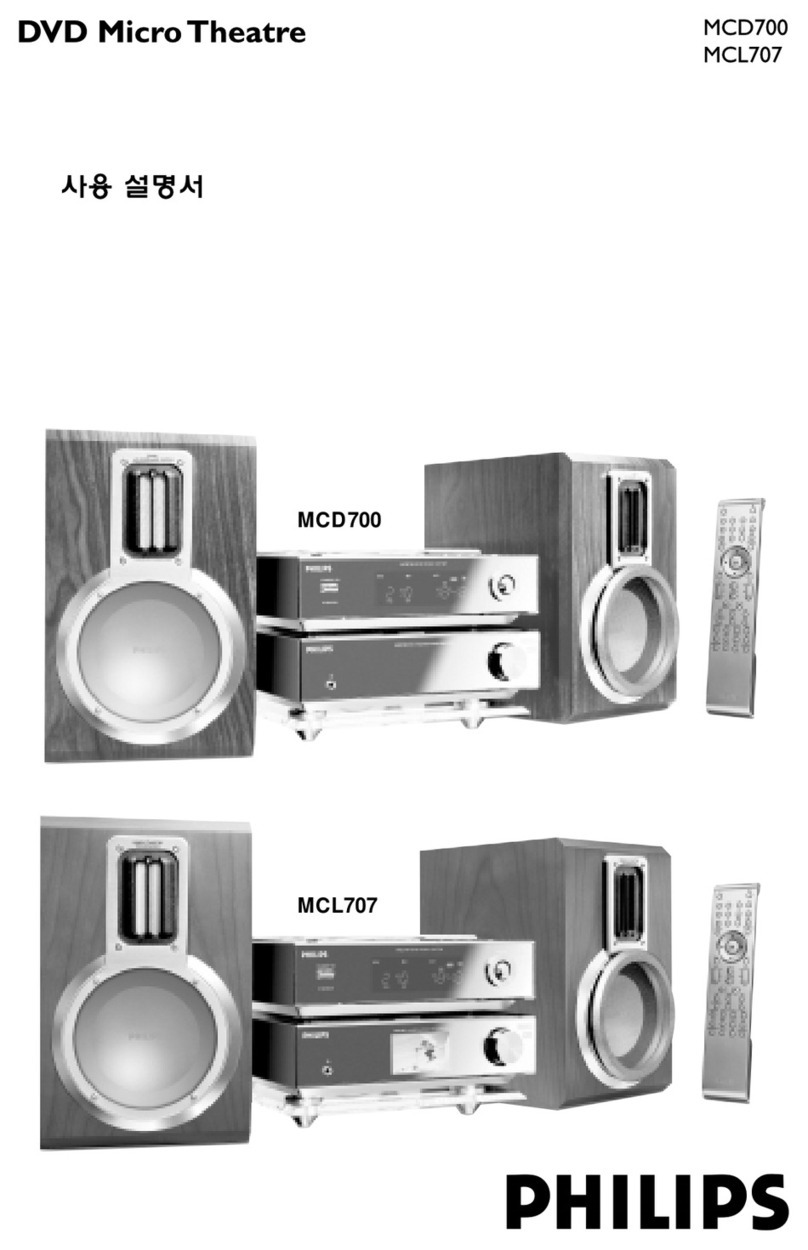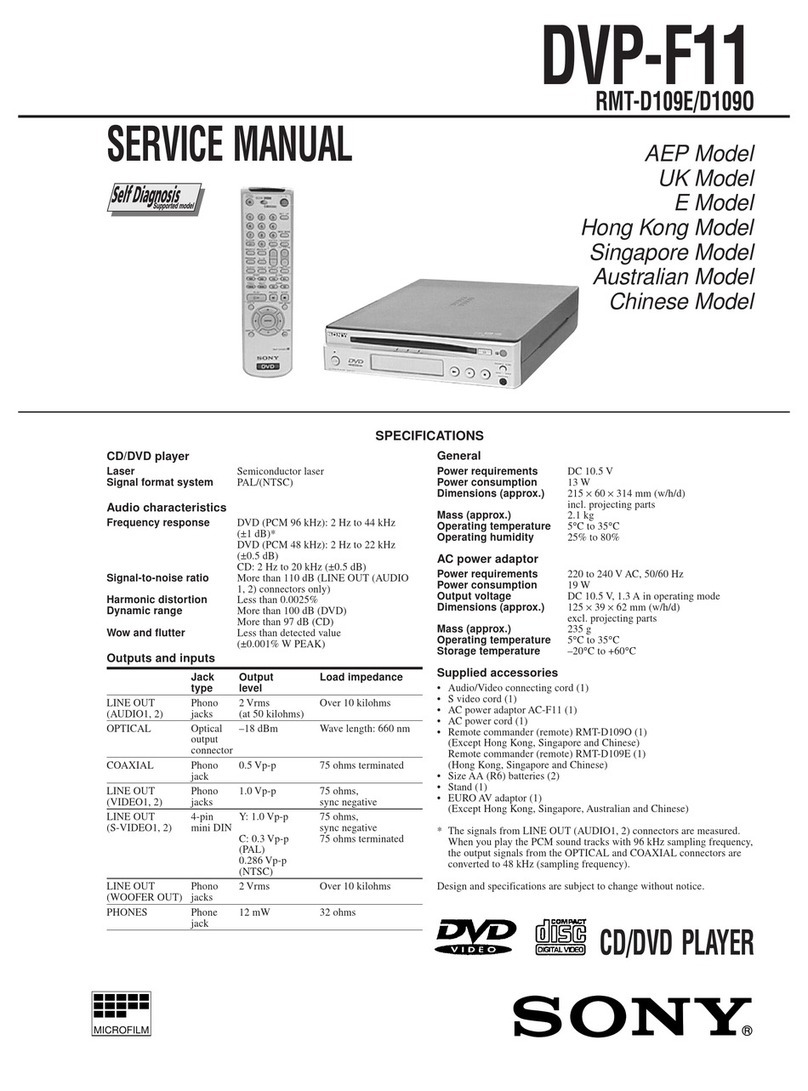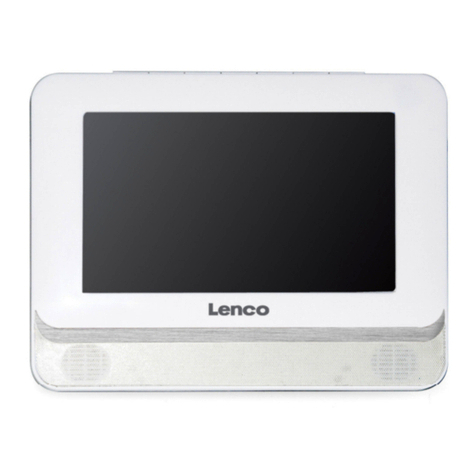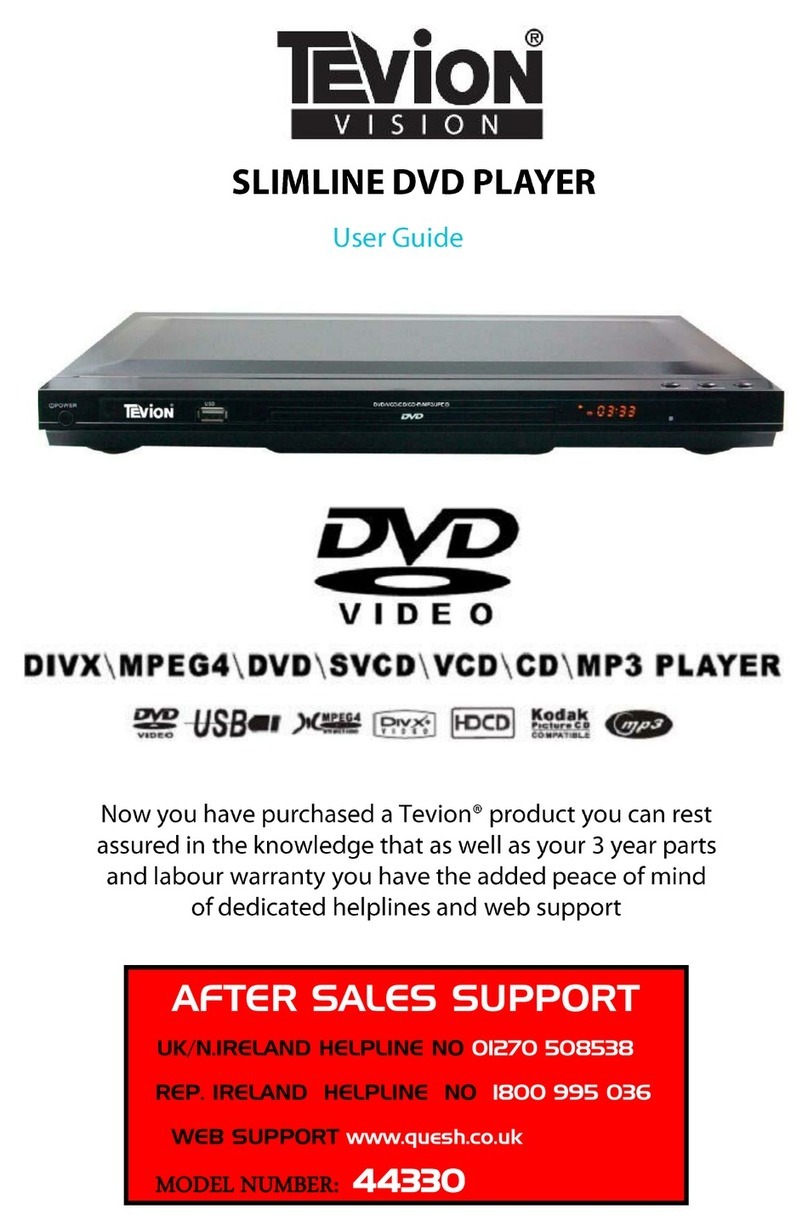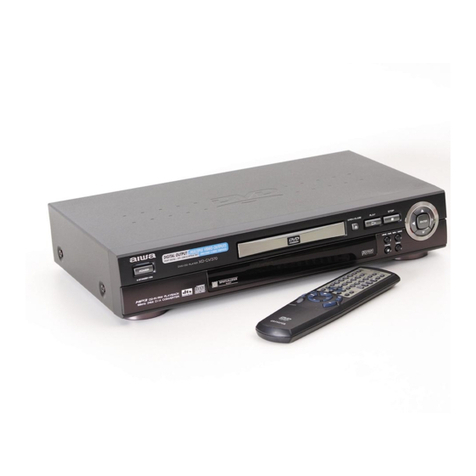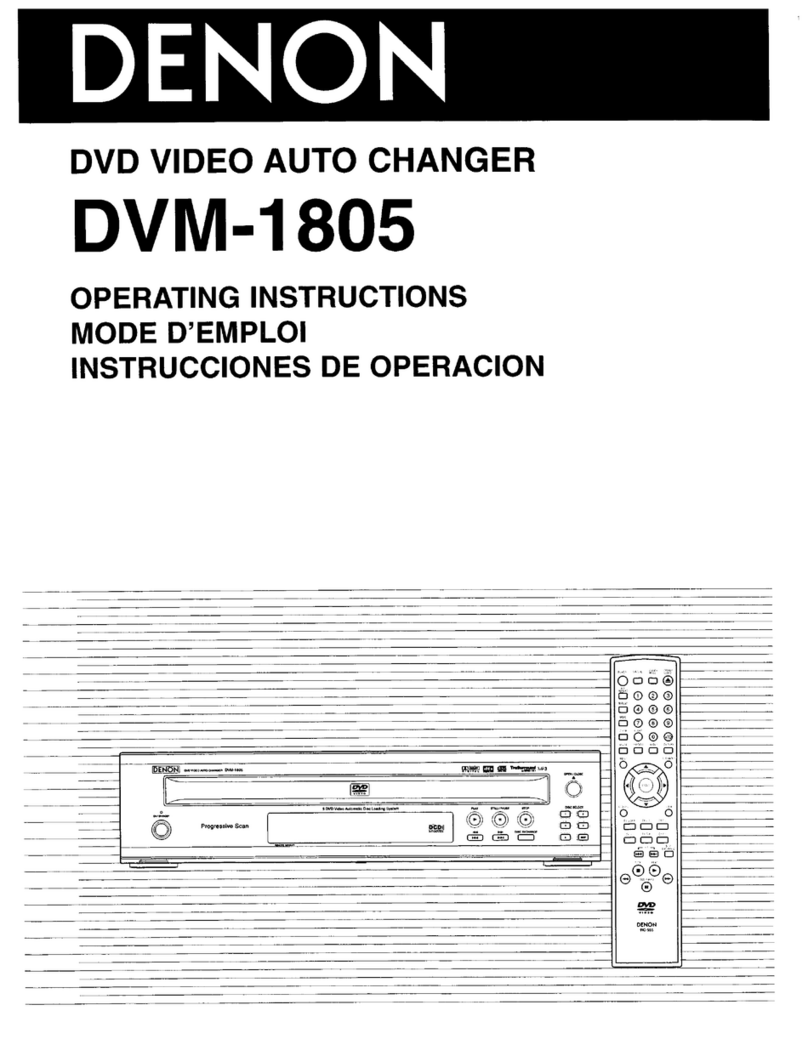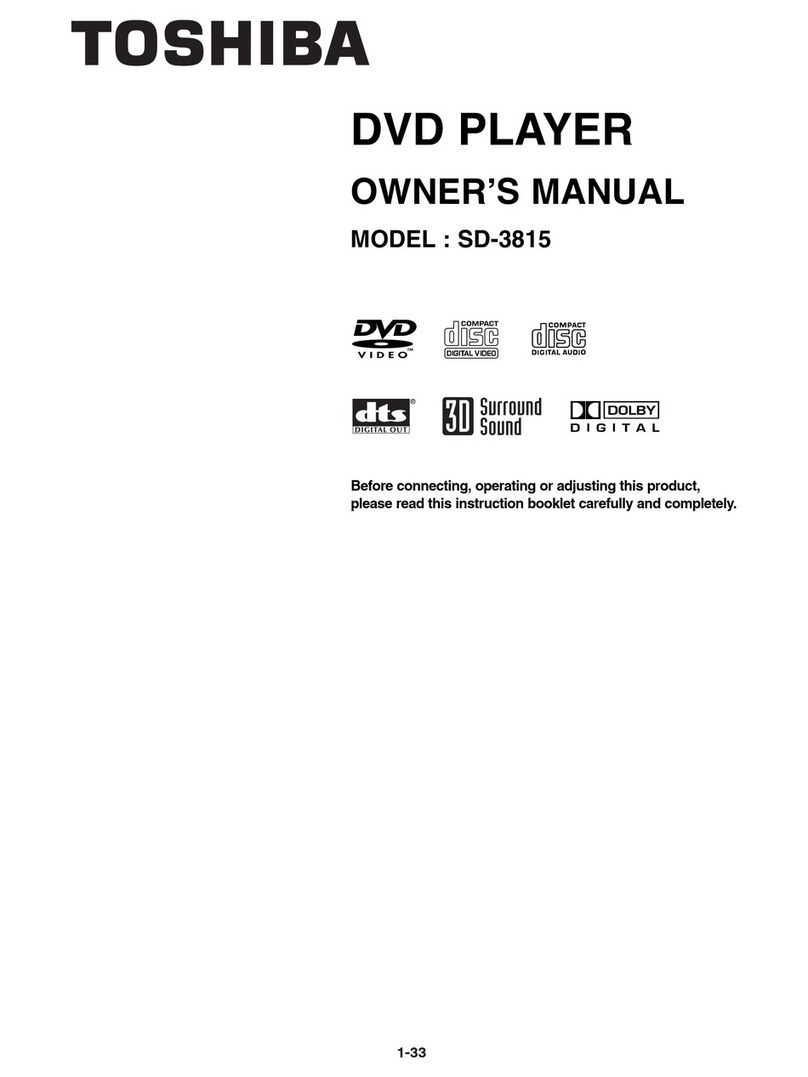5
En
Contents
01 Before you start
Features. . . . . . . . . . . . . . . . . . . . . . . . . . . .6
What’s in the box. . . . . . . . . . . . . . . . . . . . .7
Hints on installation . . . . . . . . . . . . . . . . . .8
Disc/content format playback
compatibility . . . . . . . . . . . . . . . . . . . . . . . .8
02 Connections
Easy connections. . . . . . . . . . . . . . . . . . . .11
Connecting using the S-video output . . . . .12
Connecting using the component video
output . . . . . . . . . . . . . . . . . . . . . . . . . . . .12
Connecting to an AV receiver. . . . . . . . . . .13
Connecting using HDMI . . . . . . . . . . . . . .15
About HDMI . . . . . . . . . . . . . . . . . . . . . . .16
03 Controls and displays
Front panel . . . . . . . . . . . . . . . . . . . . . . . .17
Remote control . . . . . . . . . . . . . . . . . . . . .18
Setting up the remote to control your
TV . . . . . . . . . . . . . . . . . . . . . . . . . . . . . . .19
04 Getting started
Switching on . . . . . . . . . . . . . . . . . . . . . . .20
Using the on-screen displays. . . . . . . . . . .20
Setting up the player for your TV . . . . . . . .21
Setting the language of this player’s on-screen
displays . . . . . . . . . . . . . . . . . . . . . . . . . . .21
Playing discs . . . . . . . . . . . . . . . . . . . . . . .22
05 Playing discs
Scanning discs . . . . . . . . . . . . . . . . . . . . .27
Playing in slow motion. . . . . . . . . . . . . . . .27
Frame advance/frame reverse . . . . . . . . . .27
Viewing a JPEG slideshow . . . . . . . . . . . . .28
Browsing DVD or Video CD disc with the Disc
Navigator . . . . . . . . . . . . . . . . . . . . . . . . . .28
Browsing WMA, MP3, MPEG-4 AAC, DivX
video, WMV and JPEG files with the Disc
Navigator . . . . . . . . . . . . . . . . . . . . . . . . . .29
Looping a section of a disc . . . . . . . . . . . .30
Using repeat play. . . . . . . . . . . . . . . . . . . .30
Using random play . . . . . . . . . . . . . . . . . .31
Creating a program list . . . . . . . . . . . . . . .32
Searching a disc . . . . . . . . . . . . . . . . . . . . 33
Switching subtitles . . . . . . . . . . . . . . . . . . 33
Switching audio language/channels. . . . . 34
Zooming the screen . . . . . . . . . . . . . . . . . 34
Switching camera angles . . . . . . . . . . . . . 34
Displaying disc information . . . . . . . . . . . 34
06 USB playback
Using the USB interface . . . . . . . . . . . . . . 35
07 Audio Settings and Video Adjust
menus
Audio Settings menu . . . . . . . . . . . . . . . . 36
Video Adjust menu . . . . . . . . . . . . . . . . . . 37
08 Initial Settings menu
Using the Initial Settings menu. . . . . . . . . 38
Digital Audio Out settings. . . . . . . . . . . . . 39
Video Output settings . . . . . . . . . . . . . . . . 40
Language settings . . . . . . . . . . . . . . . . . . 41
Display settings . . . . . . . . . . . . . . . . . . . . 41
Options settings . . . . . . . . . . . . . . . . . . . . 42
Parental Lock . . . . . . . . . . . . . . . . . . . . . . 42
Speakers settings . . . . . . . . . . . . . . . . . . . 45
About the HDMI audio output
settings. . . . . . . . . . . . . . . . . . . . . . . . . . . 47
HDMI output with DVD-Audio and SACD
sources. . . . . . . . . . . . . . . . . . . . . . . . . . . 48
09 Additional information
Taking care of your player and discs . . . . . 51
Screen sizes and disc formats . . . . . . . . . 52
Resetting the player . . . . . . . . . . . . . . . . . 53
DVD-Video regions . . . . . . . . . . . . . . . . . . 53
Selecting languages using the language code
list. . . . . . . . . . . . . . . . . . . . . . . . . . . . . . . 53
Troubleshooting . . . . . . . . . . . . . . . . . . . . 54
Glossary . . . . . . . . . . . . . . . . . . . . . . . . . . 59
Language code list . . . . . . . . . . . . . . . . . . 61
Country/Area code list . . . . . . . . . . . . . . . 61
Specifications . . . . . . . . . . . . . . . . . . . . . . 62
DV48AV_EN.book 5 ページ 2007年6月6日 水曜日 午前10時2分
Downloaded From Disc-Player.com Pioneer Manuals
Before you start 01
7
En
• Built-in Dolby1Digital and DTS2
decoding with multichannel outputs
This player features multichannel analog
outputs for connection to an AV amplifier to
give you stunning surround sound from Dolby
Digital, DTS and multichannel DVD-Audio
discs.
What’s in the box
Please confirm that the following accessories
are in the box when you open it.
• Remote control
• AA/R6P dry cell batteries x 2
• Audio/video cable (red/white/yellow plugs)
• Operating instructions
Putting the batteries in the remote
• Open the battery compartment cover
and insert the batteries as shown.
Use two AA/R6P batteries and follow the
indications ( , ) inside the compartment.
Close the cover when you’re finished.
Important
Incorrect use of batteries can result in hazards
such as leakage and bursting. Please observe
the following:
• Don’t mix new and old batteries together.
• Don’t use different kinds of battery
together — although they may look
similar, different batteries may have
different voltages.
• Make sure that the plus and minus ends of
each battery match the indications in the
battery compartment.
• Remove batteries from equipment that
isn’t going to be used for a month or more.
• When disposing of used batteries, please
comply with governmental regulations or
environmental public instruction’s rules
that apply in your country/area.
• Do not use or store batteries in direct
sunlight or other excessively hot place,
such as inside a car or near a heater. This
can cause batteries to leak, overheat,
explode or catch fire. It can also reduce the
life or performance of batteries.
DV48AV_EN.book 7 ページ 2007年6月6日 水曜日 午前10時2分
Downloaded From Disc-Player.com Pioneer Manuals
9
En
• Multi-session playback: No
• Unfinalized disc playback: No
• File structure (may differ): Up to 299
folders on a disc; up to 648 folders and files
(combined) within each folder
DVD+R/DVD+RW compatibility
Only DVD+R/DVD+RW discs recorded in
‘Video Mode (DVD Video Mode)’ which have
been finalized, can be played back. However,
some editing made during the recording may
not be played back accurately.
DVD-R/-RW compatibility
• Compatible formats: DVD-Video, Video
Recording (VR)*
*
• Unfinalized playback: No
• MP3/WMA/MPEG-4 AAC/JPEG or DivX
video/WMV file playback on DVD-R/-RW:
No
Compressed audio compatibility
• Compatible formats: MPEG-1 Audio Layer
3 (MP3), Windows Media Audio (WMA),
MPEG-4 AAC
• Sampling rates: 32 kHz, 44.1 kHz or 48 kHz
• Bit-rates: Any (128 kbps or higher
recommended)
• VBR (variable bit rate) MP3/WMA/MPEG-4
AAC playback: No
• WMA lossless encoding compatible: No
• DRM (Digital Rights Management)
compatible: No (DRM-protected audio files
will play in this player—see also
in the on page 59)
• File extensions: .mp3, .wma, .m4a (these
must be used for the player to recognize
MP3, WMA and MPEG-4 AAC files – do not
use for other file types)
About MPEG-4 AAC
Advanced Audio Coding (AAC) is at the core of
the MPEG-4 AAC standard, which
incorporates MPEG-2 AAC, forming the basis
of the MPEG-4 audio compression technology.
The file format and extension used depend on
the application used to encode the AAC file.
This unit plays back AAC files encoded by
iTunes®bearing the extension ‘.m4a’. DRM-
protected files will not play, and files encoded
with some versions of iTunes®may not play, or
filenames may display incorrectly.
WMA (Windows Media™ Audio)
compatibility
This player can playback Windows Media
Audio content.
WMA is an acronym for Windows Media Audio
and refers to an audio compression
technology developed by Microsoft
Corporation. WMA content can be encoded by
using Windows Media Player for Windows XP,
Windows Media Player 9 or Windows Media
Player 10 series.
About DivX video
DivX is a media technology created by DivX,
Inc. DivX media files contain not only video but
also include advanced media features like
menus, subtitles, and alternate audiotracks.
This player can play DivX videos burned on
CD-R/-RW/-ROM discs. Keeping the same
terminology as DVD-Video, individual DivX
video files are called “Titles”. When naming
files/titles on a CD-R/-RW disc prior to burning,
keep in mind that by default they will be played
in alphabetical order.
DV48AV_EN.book 9 ページ 2007年6月6日 水曜日 午前10時2分
Downloaded From Disc-Player.com Pioneer Manuals
Connections
02
11
En
Chapter 2
Connections
Easy connections
Important
• Before making or changing any connections, switch off the power and disconnect the power
cable from the AC outlet.
• The setup described here is a basic setup that allows you to play discs using just the cables
supplied with the player. In this setup, stereo audio is played through the speakers in your TV.
• This player is equipped with copy protection technology. Do not connect this player to your
TV via a VCR using audio/video or S-video cables, as the picture from this player will not
appear properly on your TV. (This player may also not be compatible with some combination
TV/VCRs for the same reason; refer to the manufacturer for more information.)
1 Connect the VIDEO OUT and AUDIO
OUT (5.1ch)/AUDIO OUT L/R jacks to a set
of A/V inputs on your TV.
Use the supplied audio/video cable,
connecting the red and white plugs to the
audio outputs and the yellow plug to the video
output. Make sure you match up the left and
right audio outputs with their corresponding
inputs for correct stereo sound.
See below if you want to use a component or
S-video cable for the video connection.
2 Plug into a power outlet.
Note
• Before unplugging the player from the
power outlet, make sure you first switch it
into standby using either the front panel
STANDBY/ON button, or the remote
control, and wait of the -OFF- message to
disappear from the player’s display.
• For the above reasons, do not plug this
player into a switched power supply found
on some amplifiers and AV receivers.
Yellow
White
Red
TV
DV48AV_EN.book 11 ページ 2007年6月6日 水曜日 午前10時2分
Downloaded From Disc-Player.com Pioneer Manuals
13
En
Watching progressive scan video
from the component video outputs
This player can output progressive scan video
from the component video output. Compared
to interlace video, progressive scan video
effectively doubles the scanning rate of the
picture, resulting in a very stable, flicker-free
image.
To set up the player for use with a progressive
scan TV, see on page 40.
When the player is set to output progressive
scan video, the PRGSVE indicator lights in the
front panel display.
Important
• If you connect a TV that is not compatible
with a progressive scan signal and switch
the player to progressive, you will not be
able to see any picture at all. In this case,
switch everything off and reconnect using
the supplied video cable (see
on page 11), then switch back
to Interlace (see below).
Switching the video output to interlace
using the front panel controls
Switch the player to standby then, using the
front panel controls, press STANDBY/ON
while pressing to switch the player back to
Interlace.
• If the player is connected using HDMI,
disconnect the HDMI cable before
resetting the player to interlace output. (If
left connected, the HDMI output
resolution will be reset to its default — see
on
page 16.)
Connecting to an AV receiver
You can connect this player to your AV receiver
using the multichannel analog outputs or one
of the digital outputs.
In addition to these connections, you should
also connect the 2 channel analog outputs for
compatibility with all discs.
You’ll probably also want to connect a video
output to your AV receiver. You can use any of
the video outputs available on this player (the
illustration shows a standard (composite)
connection).
1 Connect the analog AUDIO OUT
(5.1ch)/AUDIO OUT L/R and VIDEO OUT
jacks on this player to a set of analog audio
and video inputs on your AV receiver.
2 Connect the AV receiver’s video output
to a video input on your TV.
You can also use the S-video or component
video jacks to connect to the AV receiver if you
prefer.
Tip
• You usually have to connect the same kind
of video cable between your DVD player
and AV receiver, and between your AV
receiver and TV.
AV eceive
DV48AV_EN.book 13 ページ 2007年6月6日 水曜日 午前10時2分
Downloaded From Disc-Player.com Pioneer Manuals
15
En
Connecting using HDMI
If you have a HDMI equipped monitor or
display, you can connect it to this player using
a commercially available HDMI cable.
The HDMI connector outputs uncompressed
digital video, as well as almost every kind of
digital audio that the player is compatible with,
including DVD-Video, DVD-Audio (see below
for limitations), SACD, Video CD, CD, WMA,
MP3, MPEG-4 AAC, DivX video and WMV.
• Use an HDMI cable to connect the
HDMI OUT interconnect on this player to
an HDMI interconnect on a HDMI-
compatible display.
The arrow on the cable connector body should
be face up for correct alignment with the
connector on the player.
Note
• This unit has been designed to be
compliant with HDMI (High-Definition
Multimedia Interface). Depending on the
component you have connected, using a
DVI connection may result in unreliable
signal transfers.
• When you change the component
connected to the HDMI output, you will
also need to change the HDMI settings to
match the new component (see
on page 39, and
on page 40 to do this). However, the
settings for each component are then
stored in memory (for up to 2
components).
• The HDMI connection is compatible with 2
channel linear PCM signals (44.1 kHz to
192 kHz, 16 bit/20 bit/24 bit), and Dolby
Digital, DTS, MPEG audio bitstream, multi
channel DSD, and multi channel linear
PCM signals, (5.1 channel signals up to 96
kHz, 16 bit/20 bit/24 bit).
DV48AV_EN.book 15 ページ 2007年6月6日 水曜日 午前10時2分
Downloaded From Disc-Player.com Pioneer Manuals
Controls and displays
03
17
En
Chapter 3
Controls and displays
Front panel
1STANDBY/ON (page 20)
2 Disc tray
3TOPMENU(page 24)
4 ENTER & cursor buttons (page 20)
5MENU(page 24)
6 RETURN (page 24)
7HOMEMENU(page 20)
8Display
9OPEN/CLOSE (page 22)
10 (page 23)
11 (page 23)
12 (page 23)
13 and (page 23)
14 HDMI indicator
Lights when this player is recognized by
another HDMl or DVI/HDCP compatible
component.
15 DVD/USB (page 35)
16 USB port (Type A) (page 35)
17 RW Compatible (page 9)
DV48AV_EN.book 17 ページ 2007年6月6日 水曜日 午前10時2分
Downloaded From Disc-Player.com Pioneer Manuals
19
En
Using the remote control
Keep in mind the following when using the
remote control:
• Make sure that there are no obstacles
between the remote and the remote
sensor on the unit.
• The remote has a range of about 23 feet.
• Remote operation may become unreliable
if strong sunlight or fluorescent light is
shining on the unit’s remote sensor.
• Remote controllers for different devices
can interfere with each other. Avoid using
remotes for other equipment located close
to this unit.
• Replace the batteries when you notice a
fall off in the operating range of the
remote.
Setting up the remote to
control your TV
You can use the supplied remote to control
your TV. To be able to use this feature you first
have to program the remote with a maker code
from the table below.
1 Press and hold down the CLEAR button,
then enter the maker code for your TV.
See the table below for the list of maker codes.
If there is more than one code given for your
make, input the first one in the list.
• If the maker’s name of your TV doesn’t
appear in the table below, you will not be
able to use this remote to control your TV.
2Press TV to check that the remote
works with your TV.
If the remote is set up correctly, the TV should
switch on/off. If it doesn’t and there is another
code given for your maker, repeat step 1with a
new code.
Using the TV remote control buttons
The table below shows how to use this remote
control with your TV.
Button What it does
TV Press to switch the TV on/off
(standby)
INPUT SELECT Press to change the TV’s video
input
VOLUME +/– Use to adjust the TV volume
CHANNEL +/– Use to change TV channels
Maker Code
Aiwa 38
Funai 36
GE 11, 28
General 34
Goldstar 10, 23
Grandiente 30
Hitachi 06, 24, 25, 32
Magnavox 12, 29
Mitsubishi 09
NEC 37
Panasonic 08, 22, 41
Philips 07
Pioneer 00, 35, 40, 44
RCA 01, 15, 16, 17, 18
Samsung 73, 75
Sanyo 14, 21
Sharp 02, 19, 27
Sony 04
Toshiba 05, 26, 31, 43
JVC 13, 33, 42
Zenith 03, 20
DV48AV_EN.book 19 ページ 2007年6月6日 水曜日 午前10時2分
Downloaded From Disc-Player.com Pioneer Manuals
Getting started
04
21
En
Setting up the player for your
TV
If you have a widescreen (16:9) TV, you should
setup the player so that the picture will be
presented correctly. If you have a conventional
(4:3) TV, you can leave the player on the default
setting and move on to the next section.
1 Press HOME MENU and select ‘Initial
Settings’.
2 Select ‘TV Screen’ from the ‘Video
Output’ settings.
3 If you have a widescreen (16:9) TV,
select ‘16:9 (Wide)’ or ‘16:9 (Compressed)’.
If you have a conventional (4:3) TV, you can
change the setting from 4:3 (Letter Box) to
4:3 (Pan & Scan) if you prefer. See
on page 40 for more details.
4 Press HOME MENU to exit the menu
screen.
Setting the language of this
player’s on-screen displays
This sets the language of the player’s on-
screen displays.
1 Press HOME MENU and select ‘Initial
Settings’.
2 Select ‘OSD Language’ from the
‘Display’ settings.
3 Select a language.
The on-screen language will change according
to your selection.
4 Press HOME MENU to exit the menu
screen.
DV48AV_EN.book 21 ページ 2007年6月6日 水曜日 午前10時2分
Downloaded From Disc-Player.com Pioneer Manuals
23
En
Basic playback controls
The table below shows the basic controls on
the remote for playing discs. The following
chapter covers other playback features in
more detail.
Resume and Last Memory
With the exception of DVD-Audio and SACD
discs, when you stop playback of a DVD, CD, or
Video CD or DivX video/WMV discs, RESUME
is shown in the display indicating that you can
resume playback again from that point.
If the disc tray is not opened, the next time you
start playback the display shows RESUME and
playback resumes from the resume point. (If
you want to clear the resume point, press
(stop) while RESUME is displayed.)
With DVDs and Video CDs, if you take the disc
out of the player after stopping playback, the
last play position is stored in memory. If the
next disc you load is the same one, the display
shows LAST MEM and playback will resume.
For DVD-Video discs, the player stores the play
position of the last five discs. When one of
these discs is next loaded, you can resume
playback.
Note
• The Last Memory function doesn’t work
with VR format DVD-R/-RW, DVD-Audio or
SACD discs.
• If you don’t need the Last Memory function
when you stop a disc, you can press
OPEN/CLOSE to stop playback and
open the disc tray.
Button What it does
Starts playback.
If the display shows RESUME or
LAST MEM playback starts from the
resume or last memory point (see
also
below.)
Pauses a disc that’s playing, or
restarts a paused disc.
Stops playback.
See also
below.
(remote
only)
Press to start fast reverse scanning.
Press (play) to resume normal
playback.
(remote
only)
Press to start fast forward scanning.
Press (play) to resume normal
playback.
Skips to the start of the current
track, title or chapter, then to
previous tracks/titles/chapters.
Skips to the next track, title or
chapter.
Numbers
(remote
only)
Use to enter a title/chapter/track
number. Press ENTER to select.
• If the disc is stopped, playback
starts from the selected title (for
DVD), group (for DVD-Audio) or
track (for CD/SACD/Video CD).
• If the disc is playing, playback
jumps to the start of the selected
title (VR mode DVD-RW), chapter
(DVD-Video) or track (DVD-Audio*/
SACD/CD/Video CD).
DV48AV_EN.book 23 ページ 2007年6月6日 水曜日 午前10時2分
Downloaded From Disc-Player.com Pioneer Manuals
25
En
Video CD PBC menus
Some Video CDs have menus from which you
can choose what you want to watch. These are
called PBC (Playback control) menus.
You can play a PBC Video CD without having to
navigate the PBC menu by starting playback
using a number button to select a track, rather
than the (play) button.
FAQ
Most likely, the disc is the wrong region for
your player. The region number should be
printed on the disc; check it against the
region number of the player (which you
can find on the rear panel). See also
on page 53.
If the region number is OK, it may be that
the disc is damaged or dirty. Clean the disc
and look for signs of damage. See also
on
page 51.
First check that you loaded the disc the
right way up (label side up), and that it’s
clean and undamaged. See
on page 51 for
information on cleaning discs.
If a disc loaded correctly won’t play, it’s
probably an incompatible format or disc
type, such as DVD-ROM. See
on page 8 for
more on disc compatibility.
Some movie formats are such that even
when played on a widescreen TV, black
bars are necessary at the top and bottom
of the screen. This is not a malfunction.
Some discs override the display
preferences of the player, so even if you
have 4:3 (Pan & Scan) selected, those
discs will still be shown in letter box
format. This is not a malfunction.
Button What it does
RETURN Displays the PBC menu.
Numbers
(remote
only)
Use to enter a numbered menu
option. Press ENTER to select.
Displays the previous menu page (if
there is one).
Displays the next menu page (if
there is one).
DV48AV_EN.book 25 ページ 2007年6月6日 水曜日 午前10時2分
Downloaded From Disc-Player.com Pioneer Manuals
Playing discs
05
27
En
Chapter 5
Playing discs
Note
• Many of the functions covered in this
chapter apply to DVD and SACD discs,
Video CDs, CDs, DivX
video/WMV and MP3/WMA/MPEG-4 AAC/
JPEG discs, although the exact operation
of some varies slightly with the kind of disc
loaded.
• Some DVDs restrict the use of some
functions (random or repeat, for example)
in some or all parts of the disc. This is not
a malfunction.
• When playing Video CDs, some of the
functions are not available during PBC
playback. If you want to use them, start the
disc playing using a number button to
select a track.
Scanning discs
You can fast-scan discs forward or backward
at four different speeds (only one speed for
DivX video/WMV).
1 During playback, press or to
start scanning.
• There is no sound while scanning DVDs
(including DVD-Audio), DivX video/WMV
and Video CDs.
2 Press repeatedly to increase the
scanning speed.
• The scanning speed is shown on-screen.
3 To resume normal playback, press
(play).
• When scanning a Video CD playing in PBC
mode or a MP3/WMA/MPEG-4 AAC track,
playback automatically resumes at the end
or beginning of the track.
• Depending on the disc, normal playback
may automatically resume when a new
chapter is reached on a DVD disc.
Playing in slow motion
You can play DVD-Videos and DVD-R/-RW at
four different slow motion speeds, forwards
and backwards. Video CDs and DivX video/
WMV can be played at four different forward
slow motion speeds.
1 During playback, press (pause).
2 Press and hold or until
slow motion playback starts.
• The slow motion speed is shown on-
screen.
• There is no sound during slow motion
playback.
3 Press repeatedly to change the slow
motion speed.
4 To resume normal playback, press
(play).
• Depending on the disc, normal playback
may automatically resume when a new
chapter is reached.
Frame advance/frame reverse
You can advance or back up DVD-Video and
DVD-R/-RW discs frame-by-frame. With Video
CDs and DivX video/WMV file you can only use
frame advance.
1 During playback, press (pause).
2 Press or to reverse or
advance a frame at a time.
3 To resume normal playback, press
(play).
• Depending on the disc, normal playback
may automatically resume when a new
chapter is reached.
DV48AV_EN.book 27 ページ 2007年6月6日 水曜日 午前10時2分
Downloaded From Disc-Player.com Pioneer Manuals
29
En
The screen shows up to six moving thumbnail
images displayed one after another. To display
the previous/next six thumbnails, press /
(you don’t have to wait for all the
thumbnails to finish playing to display the
previous/next page).
3 Select the thumbnail image for what
you want to play.
You can use either the cursor buttons (
) and ENTER to select a thumbnail, or
the number buttons.
To select using the number buttons, enter a
two-digit number then press ENTER.
Tip
• Another way to find a particular place on a
disc is to use one of the search modes. See
on page 33.
Browsing WMA, MP3, MPEG-4
AAC, DivX video, WMV and
JPEG files with the Disc
Navigator
Use the Disc Navigator to find a particular file
or folder by filename. Note that if there are
other types of files on the same disc, these will
not be displayed in the Disc Navigator.
1 Press HOME MENU and select ‘Disc
Navigator’ from the on-screen menu.
2 Use the cursor buttons ( )
and ENTER to navigate.
Use the cursor up/down buttons ( ) to
move up and down the folder/file list.
Use the cursor left button ( ) to return to the
parent folder.
Use ENTER or cursor right ( ) to open a
highlighted folder.
• You can also return to the parent folder by
going to the top of the list to the ‘..’ folder,
then pressing ENTER.
• When a JPEG file is highlighted, a
thumbnail image is displayed on the right.
3 To play the highlighted track or DivX
video/WMV file or display the highlighted
JPEG file, press ENTER.
• When a MP3/WMA/MPEG-4 AAC or DivX
video/WMV file is selected, playback
begins, starting with the selected file, and
continues until the end of the folder.
• When a JPEG file is selected, a slideshow
begins, starting with that file, and
continues to the end of the folder.
DV48AV_EN.book 29 ページ 2007年6月6日 水曜日 午前10時2分
Downloaded From Disc-Player.com Pioneer Manuals
31
En
• For DivX video/WMV discs, select Title
Repeat, and for some DivX media files,
select Chapter Repeat (or Repeat Off).
Using random play
Use the random play function to play titles or
chapters (DVD-Video), Groups (DVD-Audio), or
tracks (DVD-Audio, SACD, CD, Video CD) at
random. (Note that the same track/title/
chapter may play more than once.)
You can set the random play option when a
disc is playing or stopped.
Important
• Random play remains in effect until you
select Random Off from the random play
menu options.
• You can’t use random play with VR format
DVD-R/-RW discs, Video CDs playing in
PBC mode, MP3/WMA/
MPEG-4 AAC discs, DivX video/WMV
discs, or while a DVD disc menu is being
displayed.
• You can’t use random play together with
program or repeat play.
1 Press PLAY MODE and select ‘Random’
from the list of functions on the left.
2 Select a random play option.
The random play options available depend on
the kind of disc loaded. For example, for DVD-
Video discs, you can select Random Title or
Random Chapter (or Random Off).
• For DVD-Audio discs, select Random
Group or Random Track, (or Random
Off).
• For CDs, SACDs and Video CDs, select On
or Off to switch random play on or off.
Tip
• Use the following controls during random
play:
Button What it does
Selects a new track/title/chapter
at random.
Returns to the beginning of the
current track/title/chapter;
further presses select another
random track/title/chapter.
DV48AV_EN.book 31 ページ 2007年6月6日 水曜日 午前10時2分
Downloaded From Disc-Player.com Pioneer Manuals
33
En
Searching a disc
You can search DVD-Video discs by title or
chapter number, or by time; DVD-Audio discs
can be searched by group or track number;
SACDs by track number, CDs and Video CDs
by track number or time; DivX video /WMV
discs by time, and some DivX media files by
chapter number.
Important
• Search functions are not available with
Video CDs in PBC mode, or with MP3/
WMA/MPEG-4 AAC discs.
1 Press PLAY MODE and select ‘Search
Mode’ from the list of functions on the left.
2 Select a search mode.
The search options available depend on the
kind of disc loaded.
• The disc must be playing in order to use
time search.
3 Use the number buttons to enter a title,
chapter or track number, or a time.
• For a time search, enter the number of
minutes and seconds into the currently
playing title (DVD/ DivX video/WMV) or
track (CD/Video CD) you want playback to
resume from. For example, press 4, 5, 0, 0
to have playback start from 45 minutes into
the disc. For 1 hour, 20 minutes and 30
seconds, press 8, 0, 3, 0.
• Some DVD-Audio discs feature pages of
browsable pictures. Enter the page
number you want.
4 Press ENTER to start playback.
Switching subtitles
Some DVD-Video and DivX video discs have
subtitles in one or more languages; the disc
box will usually tell you which subtitle
languages are available. You can switch
subtitle language during playback.
1 Press SUBTITLE repeatedly to select a
subtitle option.
Note
• Some discs only allow you to change
subtitle language from the disc menu.
Press TOP MENU or MENU to access.
• To set subtitle preferences, see Subtitle
Language on page 41.
• See on
page 10 for more on DivX subtitles.
DV48AV_EN.book 33 ページ 2007年6月6日 水曜日 午前10時2分
Downloaded From Disc-Player.com Pioneer Manuals
USB playback
06
35
En
Chapter 6
USB playback
Using the USB interface
It is possible to listen to two-channel audio and
watch JPEG files using the USB interface on
the front of this unit. Connect a USB mass
storage device as shown below.
Note
• This includes playback of MP3/WMA/
MPEG-4 AAC/JPEG files (except files with
copy-protection or restricted playback).
• Compatible USB devices include portable
flash memory (particularly keydrives) and
digital audio players (MP3 players) of
format FAT16/32. It is not possible to
connect this unit to a personal computer
for USB playback.
• Pioneer cannot guarantee compatibility
(operation and/or bus power) with all USB
mass storage devices and assumes no
responsibility for any loss of data that may
occur when connected to this unit.
• With large amounts of data, it may take
longer for the system to read the contents
of a USB device.
• The Home Menu cannot be displayed
while using the USB mode.
1 With the player switched on, press
DVD/USB.
Make sure your TV is on and set to the correct
video input, and that USB MODE is showing
on the front panel display.
2 Connect your USB device.
The USB terminal is located on the front panel.
• Disc Navigator is automatically displayed.
3 Press ENTER to start playback.
• The method of playback for files saved on a
USB device is the same as for other discs.
For more information, see
on page 23 and on
page 27.
4 Turn off this player and remove the
USB device.
• The next time you turn this player on it will
start up in USB mode. To return to DVD
mode, either press DVD/USB or press
OPEN/CLOSE to open the disc tray.
Important
If a USB ERR message lights in the display, it
may mean that the power requirements of the
USB device are too high for this player, or that
the device is incompatible. Try the following:
• Switch the player off, then on again.
• Reconnecting the USB device with the
player switched off.
• Change the player back to DVD mode
(LOADING will appear in the front panel
display whether a disc is inserted or not) by
pressing DVD/USB, then once again
select USB mode (USB MODE will appear
in the front panel display).
• Using a dedicated AC adapter (supplied
with the device) for USB power.
If this doesn’t remedy the problem, it is likely
your USB device is incompatible.
USB mass
sto age device
DV48AV_EN.book 35 ページ 2007年6月6日 水曜日 午前10時2分
Downloaded From Disc-Player.com Pioneer Manuals
Audio Settings and Video Adjust menus
07
37
En
• How good the surround effect is varies
with the disc.
Note
• 96 kHz linear PCM audio is automatically
downsampled to 48 kHz if the Equalizer is
switched on.
Dialog
•Settings:High, Medium, Low, Off
The Dialog feature is designed to make the
dialog stand out from other background
sounds in the soundtracks.
Video Adjust menu
From the Video Adjust screen you can adjust
various settings that affect how the picture is
presented.
1 Press HOME MENU and select ‘Video
Adjust’ from the on-screen display.
2 Make settings using the
(cursor) buttons, and ENTER.
You can adjust the following picture quality
settings:
•Sharpness – Adjusts the sharpness of
edges in the picture (Fine, Standard
, Soft).
•Brightness – Adjusts the overall
brightness (–20 to +20).
•Contrast – Adjusts the contrast between
light and dark (–16 to +16).
•Gamma – Adjusts the ‘warmth’ of the
picture (High, Medium, Low, Off
).
•Hue – Adjusts the red/green balance
(green 9 to red 9).
•Chroma Level – Adjusts how saturated
colors appear (–9 to +9).
•BNR – Switches on/off block noise
reduction (On, Off ).
Adjust the Brightness, Contrast, Hue and
Chroma Level settings using the (cursor
left/right) buttons.
3 Press ENTER to return to the Video
Adjust screen, or HOME MENU to exit.
DV48AV_EN.book 37 ページ 2007年6月6日 水曜日 午前10時2分
Downloaded From Disc-Player.com Pioneer Manuals
Initial Settings menu
08
39
En
Digital Audio Out settings
Setting Option What it means
Digital Out On Digital audio is output from the digital outputs.
No digital audio output.
Dolby Digital Out Dolby Digital Dolby Digital encoded digital audio is output when playing a
Dolby Digital DVD disc.
Dolby Digital audio is converted to PCM audio before being
output.
DTS Out DTS DTS encoded digital audio is output when playing a DTS disc.
(Noise will be output if your amplifier/receiver is not
compatible with DTS audio.)
No digital audio is output when playing a DTS disc.DTS audio
is converted to PCM audio before being output.
Linear PCM Out Down Sample On 96 kHz digital audio is converted to 48 kHz for digital output.
96 kHz digital audio is output as is at 96 kHz.
MPEG Out MPEG > PCM MPEG encoded digital audio is converted to PCM audio for
digital output.
MPEG encoded digital audio is output as is.
HDMI Out LPCM (2CH) Set if your monitor or device only accepts stereo input. On
this setting multichannel audio is downmixed to 2 channels
for stereo linear PCM output.
Set if the monitor or device you have connected using HDMI
is compatible with Liner PCM multi-channel formats. All
audio signals are output as linear PCM 5.1 format. (Use this
setting if you want to decode all streams by a player)
Dolby Digital, DTS and MPEG sources are processed
according to how they were encoded, and linear PCM
sources are heard as is. SACD sources are output as linear
PCM.
Set if you want to output DSD audio from an SACD source.
No digital audio output. Choose this option when you want to
change the Digital Audio Out, SACD Playback and
Speakers settings.
DV48AV_EN.book 39 ページ 2007年6月6日 水曜日 午前10時2分
Downloaded From Disc-Player.com Pioneer Manuals
41
En
Language settings
Display settings
Setting Option What it means
Audio Language English If there is an English soundtrack on the disc then it will be
played.
If there is the language selected on the disc, then it will be
played.
Select to choose a language other than the ones displayed
(see page 53).
Subtitle Language
(See also
on
page 10.)
English If there are English subtitles on the disc then they will be
displayed.
If there is the subtitle language selected on the disc, then it
will be displayed.
Select to choose a language other than the ones displayed
(see page 53).
DVD Menu
Lang.
w/Subtitle Lang. DVD disc menus will be displayed in the same language as
your selected subtitle language, if possible.
DVD disc menus will be displayed in the selected language,
if possible.
Select to choose a language other than the ones displayed
(see page 53).
Subtitle Display On Subtitles are displayed according to your selected subtitle
language (see above).
Subtitles are always off by default when you play a DVD disc
(note that some discs override this setting).
Setting Option What it means
OSD Language English On-screen displays of the player are in English.
On-screen displays are shown in the language selected.
Angle Indicator On A camera icon is displayed on-screen during multi-angle
scenes on a DVD disc.
No multi-angle indication is shown.
DV48AV_EN.book 41 ページ 2007年6月6日 水曜日 午前10時2分
Downloaded From Disc-Player.com Pioneer Manuals
43
En
Changing your password
To change your password, confirm your
existing password then enter a new one.
1 Select ‘Password Change’.
2 Use the number buttons to enter your
existing password, then press ENTER.
3 Enter a new password and press ENTER.
This registers the new password and you will
return to the Options menu screen.
Setting/changing the Parental Lock
1 Select ‘Level Change’.
2 Use number buttons to enter your
password, then press ENTER.
3 Select a new level and press ENTER.
• Press (cursor left) repeatedly to lock
more levels (more discs will require the
password); press (cursor right) to
unlock levels. You can’t lock level 1.
This sets the new level and you will return to
the Options menu screen.
Setting/changing the Country/Area
code
You can find the on
page 61.
1 Select ‘Country Code’.
2 Use number buttons to enter your
password, then press ENTER.
3 Select a Country/Area code and press
ENTER.
There are two ways you can do this:
• Select by code letter: Use (cursor up/
down) to change the Country/Area code.
• Select by code number: Press (cursor
right) then use the number buttons to
enter the 4-digit Country/Area code.
The new Country/Area code is set and you will
return to the Options menu screen. Note that
the new Country/Area code doesn’t take effect
until the next disc is loaded (or the current disc
is reloaded).
DTS Downmix
• Default setting: STEREO
If you’ve selected DTS > PCM in on
page 39 or 2 Channel in on
page 45, you can choose the way the signal is
downmixed to PCM audio. STEREO will
downmix the DTS signal to 2-channel stereo,
whereas Lt/Rt will downmix to a 2-channel
signal compatible with Dolby surround matrix
decoders. (This allows you to hear surround
sound if your AV receiver or amplifier has
Dolby Pro Logic capability.)
DV48AV_EN.book 43 ページ 2007年6月6日 水曜日 午前10時2分
Downloaded From Disc-Player.com Pioneer Manuals
45
En
Speakers settings
Audio Output Mode
• Default setting: 2 Channel
If you connected this player to your amplifier
using the 5.1 channel analog outputs (front,
surround, center and subwoofer outs), set this
to 5.1 Channel; if you connected only the
stereo outs, set to 2 Channel.
Note
• Even if you set Audio Output Mode to
5.1 Channel, you’ll only get sound from all
speakers when playing a 5.1 channel
multi-channel disc.
• When set to 5.1 Channel, only the front left/
right channels are output from the AUDIO
OUT (2ch) jacks. Change to 2 Channel if
you want to listen to downmixed stereo
audio (for example, because you are
listening through the TV’s built-in
speakers).
• When set to 5.1 Channel there is no digital
output when playing DVD-Audio.
•Ifyousetto2 Channel, Dolby Digital, DTS
and MPEG audio is mixed down to two
channels so you still hear all the audio
recorded on the disc. With DTS encoded
audio, you can choose how the signal is
downmixed to PCM audio. See
on page 43 to change the
downmix setting.
• Some DVD-Audio discs don’t allow down-
mixing of audio. These discs always output
multi-channel audio regardless of the
setting made here.
Setting Option What it means
Audio Output
Mode
2 Channel The player outputs analog audio in stereo only. See also
below.
The player outputs 5.1 channel analog audio. See also
below.
Speaker Distance – Specify the distance of your speakers from your listening
position. See also on page 49.
Speaker
Installation
–Specify the number and size of speakers in your system. See
also on page 50.
DV48AV_EN.book 45 ページ 2007年6月6日 水曜日 午前10時2分
Downloaded From Disc-Player.com Pioneer Manuals
47
En
About the HDMI audio output settings
The table below shows how the audio settings you make in the HDMI Out (see on
page 39) and Audio Output Mode screens ( on page 45) affect the HDMI
output with various types of disc.
*1These formats include DVD-RW discs.
*2If the connected component is not DVD-Audio (CPPM) compatible, it is not possible to output
CPPM copy-controlled DVD-Audio sources from the HDMI connection (see
on page 48 for more on this).
*3If the discs prohibit downmixing, output Front L/R.
*4If the HDMI device you are using is not compatible with Multi-ch formats, the output signal is
the same as LPCM (2CH) setting.
*5If the HDMI device you are using is not compatible with these compressed formats, the signal
is output as linear PCM.
*6If the connected HDMI device is not compatible with protected audio contents (such as
DVD-Audio or SACD), SACD audio is not output from the HDMI terminal.
*7 Analog SACD audio is not output when you have set to Auto (DSD).
DV48AV_EN.book 47 ページ 2007年6月6日 水曜日 午前10時2分
Downloaded From Disc-Player.com Pioneer Manuals
49
En
Speaker Distance
• Default settings: all speakers 10.0ft
To get the best surround sound from your
system, you should set up the speaker
distances from your listening position.
1Usethe (cursor up/down) to select
a speaker.
•The
Land Rspeakers are paired; you can’t
set them differently.
2Press (cursor right) to change the
speaker distance for the highlighted
speaker.
3Usethe (cursor up/down) to
change the distance.
• When you change the distance settings of
the front left (L) or front right (R) speakers,
all the other speaker distances change
relative to it.
• Front left/right (L/R) speaker distances can
be set from 1.0 ft to 30.0 ft in 1.0 ft
increments.
• The center speaker (C) can be set from
–7.0 ft to 0.0 ft relative to the front left/right
speakers.
• Surround left/right (SL/SR) speakers can
be set from –20.0 ft to 0.0 ft relative to the
front left/right speakers.
• You can’t set the subwoofer (SW) distance.
4 Press (cursor left) to go back to the
speaker list if you want to modify another
speaker, or press ENTER to exit the Speaker
Distance screen.
Note
During playback of SACD and MPEG-audio
DVD-Video discs, the effective C, SL and SR
speaker distance settings are –3.0 ft to 0.0 ft
relative to the front left/right speakers.
DV48AV_EN.book 49 ページ 2007年6月6日 水曜日 午前10時2分
Downloaded From Disc-Player.com Pioneer Manuals
Additional information
09
51
En
Chapter 9
Additional information
Taking care of your player and
discs
General
Hold discs by the edge or by the center hole
and edge.
When you’re not using a disc, return it to its
case and store upright. Avoid leaving discs in
excessively cold, humid, or hot environments
(including under direct sunlight).
Don’t glue paper or put stickers on to discs. Do
not use a pencil, ball-point pen or other sharp-
tipped writing instrument to write on the disc.
Don’t use self-adhesive disc labels on discs as
these can cause the disc to warp slightly
during playback causing distortion in the
picture and/or sound.
Damaged and shaped discs
Do not use cracked, chipped, warped, or
otherwise damaged discs as they may damage
the player.
This player is designed to be used only with
conventional, fully circular discs. Do not use
shaped discs. Pioneer disclaims all liability
arising in connection with the use of shaped
discs.
Cleaning discs
Fingerprints and dust on discs can affect
playback performance. Clean using a soft, dry
cloth, wiping the disc lightly from the center to
the outside edge as shown below.
If necessary, use a cloth soaked in alcohol, or
a commercially available CD/DVD cleaning kit
to clean a disc more thoroughly. Never use
benzine, thinner or other cleaning agents,
including products designed for cleaning vinyl
records.
Cleaning the unit’s exterior
Unplug the unit before cleaning.
Use a dry cloth to wipe off dust and dirt. If the
surfaces are very dirty, wipe with a soft cloth
dipped in some neutral cleanser diluted five or
six times with water and wrung out well, then
wipe again with a dry cloth.
Do not use furniture wax or cleaners. Never
use thinners, benzine or insecticide sprays or
other chemicals on or near this unit.
If you use a chemical-impregnated cleaning
cloth, read the instructions carefully before
use. These cloths may leave smear marks on
half-mirror finish surfaces; if this happens,
finish with a dry cloth.
Cleaning the pickup lens
The DVD player’s lens should not become dirty
in normal use, but if for some reason it should
malfunction due to dust or dirt, consult your
nearest Pioneer-authorized service center. We
do not recommend using commercially
available lens cleaners for CD players.
DV48AV_EN.book 51 ページ 2007年6月6日 水曜日 午前10時2分
Downloaded From Disc-Player.com Pioneer Manuals
53
En
Resetting the player
Use this procedure to reset all the player’s
settings to the factory default.
1 Switch the player into standby.
2 Using the front panel buttons, hold
down the (stop) button and press
STANDBY/ON to switch the player back
on.
All the player’s settings are now reset.
DVD-Video regions
All DVD-Video discs carry a region mark on the
case somewhere that indicates which
region(s) of the world the disc is compatible
with. Your DVD player also has a region mark,
which you can find on the rear panel. Discs
from incompatible regions will not play in this
player. In this case the attention sentence
Incompatible disc region number Can’t
play disc is displayed on screen. Discs
marked ALL will play in any player. The
diagram below shows the various DVD regions
of the world.
Selecting languages using the
language code list
Some of the language options (such as ‘DVD
Menu Lang.’ in the Initial Settings) allow you to
set your preferred language from any of the
136 languages listed in the language code list
on page 61.
1 Select ‘Other Language’.
2Usethe (cursor left/right)
buttons to select either a code letter or a
code number.
3Usethe (cursor up/down) buttons
to select a code letter or a code number.
See on page 61 for a
complete list of languages and codes.
DV48AV_EN.book 53 ページ 2007年6月6日 水曜日 午前10時2分
Downloaded From Disc-Player.com Pioneer Manuals
55
En
No picture/No color. • Incorrect video connections: Check that connections are correct and
that plugs are inserted fully. Also check the video cable for damage.
• TV/monitor or AV amplifier settings are incorrect: Check the
instruction manual of the connected equipment.
• The video output is set to progressive but your TV/monitor is not
compatible with progressive scan: See page 13 for how to set to
Interlace.
Screen is stretched or
aspect does not change.
• The TV Screen setting in the Initial Settings menu is incorrect. See
page 52 for how to set it correctly for your TV/monitor.
Picture disturbance
during playback or the
picture is dark.
• This player is compatible with Macro-Vision System copy guard.
Some discs include a copy prevention signal, and when this type of
disc is played back, stripes etc., may appear on some sections of the
picture depending on the TV. This is not a malfunction.
• Due to the player’s copy protection circuits, connection of this device
through a VCR or an AV selector may prevent recording or cause
picture problems. This is not a malfunction.
No audio, or audio is
distorted.
• No audio is output during slow motion playback or when scanning
discs other than audio CDs and SACDs.
• Some DVD discs do not output digital audio: Switch your amplifier to
the player’s analog outputs.
• Check that the disc is free from dust and dirt, and that it is not
damaged (page 51).
• Check that all interconnects are firmly inserted.
• Check that the plugs and terminals are free of dirt, oxide, etc. and
clean if necessary. Also check the cable for damage.
• Make sure the player’s output is not connected to the amplifier’s
phono (turntable) inputs.
• Check your amplifier/receiver’s settings (volume, input function,
speaker settings, etc.).
The analog audio is OK,
but there appears to be
no digital audio signal.
• Make sure that the Digital Out setting is set to On (page 39).
• Check that the Dolby Digital, DTS and MPEG out settings (page 39)
are suitable for your amplifier/receiver — check the instruction manual
that came with your amplifier/receiver.
• SACDs and some DVD-Audio discs do not output digital audio.
Listen through the player’s analog audio outputs.
Noticeable difference in
DVD and CD volume.
• This is due to differences in the audio format and is not a
malfunction.
Problem Remedy
DV48AV_EN.book 55 ページ 2007年6月6日 水曜日 午前10時2分
Downloaded From Disc-Player.com Pioneer Manuals
57
En
HDMI troubleshooting
Problem Remedy
No HDMI audio output. • Check whether or not HDMI Out is set to Off. (See on
page 39.)
• This unit has been designed to be compliant with HDMI (High-
Definition Multimedia Interface). Depending on the component you
have connected, unreliable signal transfers may result.
• If the front panel HDMI indicator is lit:
– You won’t hear any sound from the HDMI output if the source
component is only DVI/HDCP-compatible.
• If the front panel
HDMI
indicator is unlit then:
– Make sure that you’ve selected this player as the HDMI input in the
settings for the component you’re using. You may need to refer to the
instruction manual of the component to do this.
– Check that the HDMI cable is connected properly and that the cable
isn’t damaged.
– Check that components connected using the HDMI interface are
switched on and HDMI compatible.
No HDMI video output. • Make sure that you’ve selected this player as the HDMI input in the
settings for the component you’re using. You may need to refer to the
instruction manual of the component to do this.
• Check that the HDMI cable is connected properly and that the cable
isn’t damaged.
• Check that components connected using the HDMI interface are
switched on and HDMI compatible.
• This unit has been designed to be compliant with HDMI (High
Definition Multimedia Interface). Depending on the component you
have connected, using a DVI connection may result in unreliable signal
transfers.
• Make sure the resolution on this player matches that of the
component you have connected using HDMI. See on
page 40 to change the HDMI resolution. See
on page 16 if you
want to reset the output resolution.
No multichannel HDMI
audio.
• Make sure the HDMI Out setting is set to Auto, Auto (DSD) or
LPCM (5.1CH) (see on page 39 to do this). See also
on page 47 and
on page 48.
No sound is output from
the AUDIO OUT (5.1ch)
jack when connected via
HDMI.
• Check whether or not HDMI Out is set to Off. (See on
page 39.)
Component Out cannot
be set to Interlace.
• You can use the Interlace setting if the HDMI Resolution is set to
720 x 480i.
DV48AV_EN.book 57 ページ 2007年6月6日 水曜日 午前10時2分
Downloaded From Disc-Player.com Pioneer Manuals
59
En
Glossary
Analog audio Direct representation of sound by an
electrical signal. See also .
Aspect ratio The width of a TV screen relative to its
height. Conventional TVs are 4:3;
widescreen models are 16:9.
Bonus Group
(DVD-Audio
only)
An ‘extra’ group on some DVD-Audio
discs that requires a key number to
access.
Browsable
pictures
(DVD-Audio
only)
A feature of some DVD-Audio discs in
which the user can browse still
pictures recorded on the disc as the
audio is played.
Digital audio Indirect representation of sound using
numbers. See also
and .
DivX DivX is a media technology created by
DivX, Inc. DivX media files contain not
only video but also include advanced
media features like menus, subtitles,
and alternate audiotracks.
Dolby Digital A multi-channel audio encoding
system developed by Dolby
Laboratories that enables far more
audio to be stored on a disc than PCM
encoding. See also
.
DRM DRM (digital rights management) copy
protection is a technology designed to
prevent unauthorized copying by
restricting playback, etc. of
compressed audio files on devices
other than the PC (or other recording
equipment) used to record it. For
detailed information, please see the
instruction manuals or help files that
came with your PC and/or software.
DTS A multi-channel audio encoding
system developed by Digital Theater
Systems that enables far more audio to
be stored on a disc than PCM
encoding. See also
.
DSD
(Direct
Stream
Digital)
The Digital Audio encoding system
found on SACDs, that expresses the
audio signals by the pulse density of
one bit data.
EXIF
(Exchangeable
Image File)
A file format developed by FUJIFILM for
digital still cameras. Digital cameras
from various manufacturers use this
compressed file format which carries
date, time and thumbnail information,
as well as the picture data.
File
extension
A tag added to the end of a filename to
indicate the type of file. For example,
“.mp3” indicates an MP3 file.
HDMI HDMI (High-Definition Multimedia
Interface) is a high-speed digital
interface which has the capability to
support standard, enhanced, or high-
definition video plus standard to multi-
channel surround-sound audio on a
single digital connection. HDMI
features include uncompressed digital
video, a bandwidth of up to 5 gigabytes
per second and communication
between the AV source and AV devices
such as DTVs.
ISO 9660
format
International standard for the volume
and file structure of CD-ROM discs.
JPEG A standard file format used for still
images. JPEG files are identified by the
file extension “.jpg”.
MP3 MP3 (MPEG1 audio layer 3) is a
compressed stereo audio file format.
Files are recognized by their file
extension “.mp3”.
MPEG-4 AAC MPEG-4 AAC is a compressed stereo
audio file format. Files are recognized
by the extention ‘.m4a’.
Note that some files purchased with
copyright protection (such as files from
the iTunes store) may not playback.
MPEG audio An audio format used on Video CDs
and some DVD discs.
Packed PCM
(DVD-Audio
only)
A lossless compression system that
enables more PCM audio to be stored
on a DVD-Audio disc than would
otherwise be possible.
PBC
(PlayBack
Control)
A system of navigating a Video CD
through on-screen menus recorded
onto the disc.
PCM
(Pulse Code
Modulation)
Digital audio encoding system found
on CDs. Good quality, but requires a lot
of data compared to Dolby Digital, DTS
and MPEG encoded audio. See also
.
DV48AV_EN.book 59 ページ 2007年6月6日 水曜日 午前10時2分
Downloaded From Disc-Player.com Pioneer Manuals
61
En
Language code list
Language (Language code letter), Language code
Country/Area code list
Country/Area, Country/Area code, Country/Area code letter
Japanese (ja), 1001
English (en), 0514
French (fr), 0618
German (de), 0405
Italian (it), 0920
Spanish (es), 0519
Chinese (zh), 2608
Dutch (nl), 1412
Portuguese (pt), 1620
Swedish (sv), 1922
Russian (ru), 1821
Korean (ko), 1115
Greek (el), 0512
Afar (aa), 0101
Abkhazian (ab), 0102
Afrikaans (af), 0106
Amharic (am), 0113
Arabic (ar), 0118
Assamese (as), 0119
Aymara (ay), 0125
Azerbaijani (az), 0126
Bashkir (ba), 0201
Byelorussian (be), 0205
Bulgarian (bg), 0207
Bihari (bh), 0208
Bislama (bi), 0209
Bengali (bn), 0214
Tibetan (bo), 0215
Breton (br), 0218
Catalan (ca), 0301
Corsican (co), 0315
Czech (cs), 0319
Welsh (cy), 0325
Danish (da), 0401
Bhutani (dz), 0426
Esperanto (eo), 0515
Estonian (et), 0520
Basque (eu), 0521
Persian (fa), 0601
Finnish (fi), 0609
Fiji (fj), 0610
Faroese (fo), 0615
Frisian (fy), 0625
Irish (ga), 0701
Scots-Gaelic (gd), 0704
Galician (gl), 0712
Guarani (gn), 0714
Gujarati (gu), 0721
Hausa (ha), 0801
Hindi (hi), 0809
Croatian (hr), 0818
Hungarian (hu), 0821
Armenian (hy), 0825
Interlingua (ia), 0901
Interlingue (ie), 0905
Inupiak (ik), 0911
Indonesian (in), 0914
Icelandic (is), 0919
Hebrew (iw), 0923
Yiddish (ji), 1009
Javanese (jw), 1023
Georgian (ka), 1101
Kazakh (kk), 1111
Greenlandic (kl), 1112
Cambodian (km), 1113
Kannada (kn), 1114
Kashmiri (ks), 1119
Kurdish (ku), 1121
Kirghiz (ky), 1125
Latin (la), 1201
Lingala (ln), 1214
Laothian (lo), 1215
Lithuanian (lt), 1220
Latvian (lv), 1222
Malagasy (mg), 1307
Maori (mi), 1309
Macedonian (mk), 1311
Malayalam (ml), 1312
Mongolian (mn), 1314
Moldavian (mo), 1315
Marathi (mr), 1318
Malay (ms), 1319
Maltese (mt), 1320
Burmese (my), 1325
Nauru (na), 1401
Nepali (ne), 1405
Norwegian (no), 1415
Occitan (oc), 1503
Oromo (om), 1513
Oriya (or), 1518
Panjabi (pa), 1601
Polish (pl), 1612
Pashto, Pushto (ps), 1619
Quechua (qu), 1721
Rhaeto-Romance (rm), 1813
Kirundi (rn), 1814
Romanian (ro), 1815
Kinyarwanda (rw), 1823
Sanskrit (sa), 1901
Sindhi (sd), 1904
Sangho (sg), 1907
Serbo-Croatian (sh), 1908
Sinhalese (si), 1909
Slovak (sk), 1911
Slovenian (sl), 1912
Samoan (sm), 1913
Shona (sn), 1914
Somali (so), 1915
Albanian (sq), 1917
Serbian (sr), 1918
Siswati (ss), 1919
Sesotho (st), 1920
Sundanese (su), 1921
Swahili (sw), 1923
Tamil (ta), 2001
Telugu (te), 2005
Tajik (tg), 2007
Thai (th), 2008
Tigrinya (ti), 2009
Turkmen (tk), 2011
Tagalog (tl), 2012
Setswana (tn), 2014
Tonga (to), 2015
Turkish (tr), 2018
Tsonga (ts), 2019
Tatar (tt), 2020
Twi (tw), 2023
Ukrainian (uk), 2111
Urdu (ur), 2118
Uzbek (uz), 2126
Vietnamese (vi), 2209
Volapük (vo), 2215
Wolof (wo), 2315
Xhosa (xh), 2408
Yoruba (yo), 2515
Zulu (zu), 2621
Argentina, 0118, ar
Australia, 0121, au
Austria, 0120, at
Belgium, 0205, be
Brazil, 0218, br
Canada, 0301, ca
Chile, 0312, cl
China, 0314, cn
Denmark, 0411, dk
Finland, 0609, fi
France, 0618, fr
Germany, 0405, de
Hong Kong, 0811, hk
India, 0914, in
Indonesia, 0904, id
Italy, 0920, it
Japan, 1016, jp
Korea, Republic of, 1118, kr
Malaysia, 1325, my
Mexico, 1324, mx
Netherlands, 1412, nl
New Zealand, 1426, nz
Norway, 1415, no
Pakistan, 1611, pk
Philippines, 1608, ph
Portugal, 1620, pt
Russian Federation,
1821
,
ru
Singapore, 1907, sg
Spain, 0519, es
Sweden, 1905, se
Switzerland, 0308, ch
Taiwan, 2023, tw
Thailand, 2008, th
United Kingdom, 0702, gb
USA, 2119, us
DV48AV_EN.book 61 ページ 2007年6月6日 水曜日 午前10時2分
Downloaded From Disc-Player.com Pioneer Manuals





